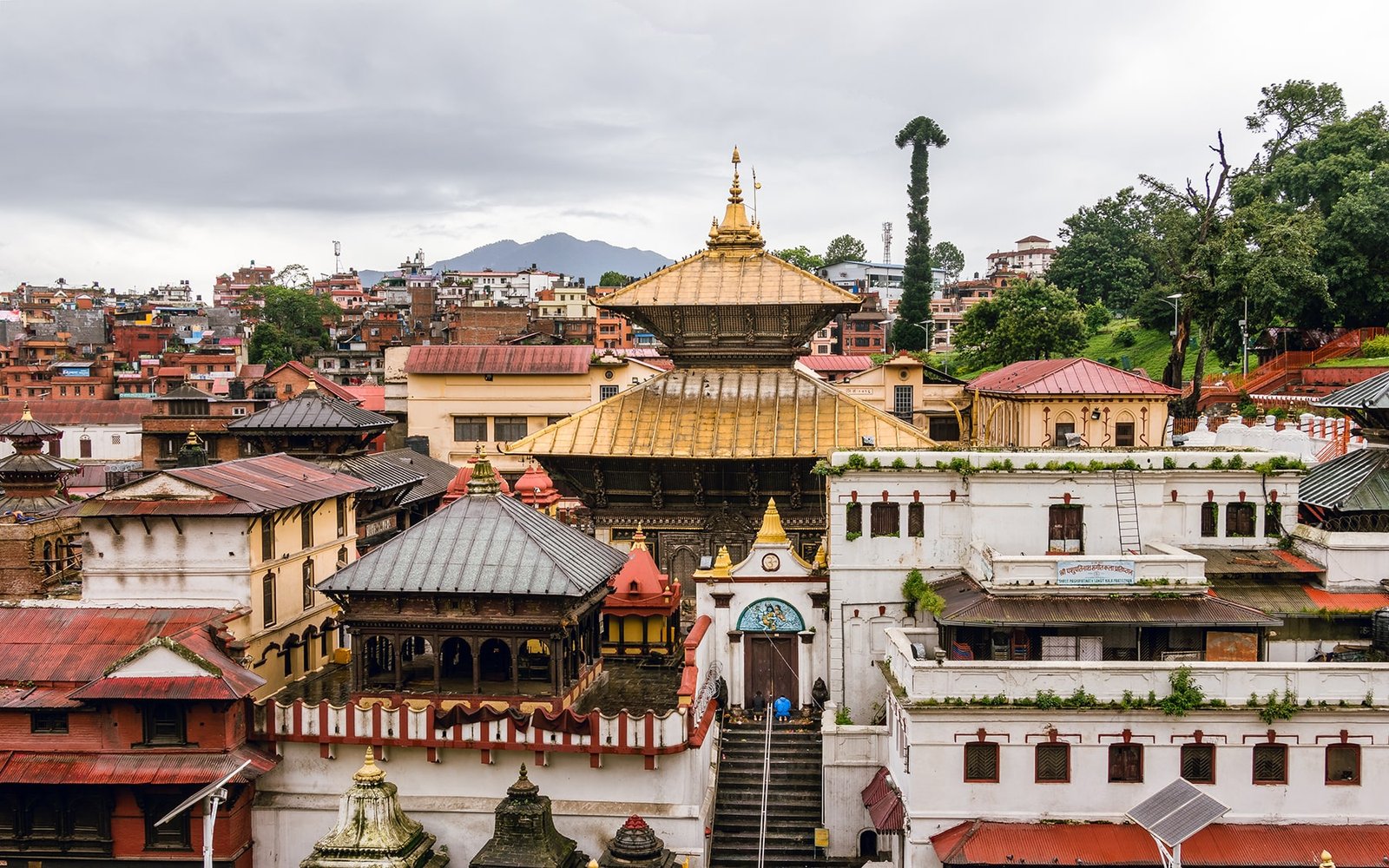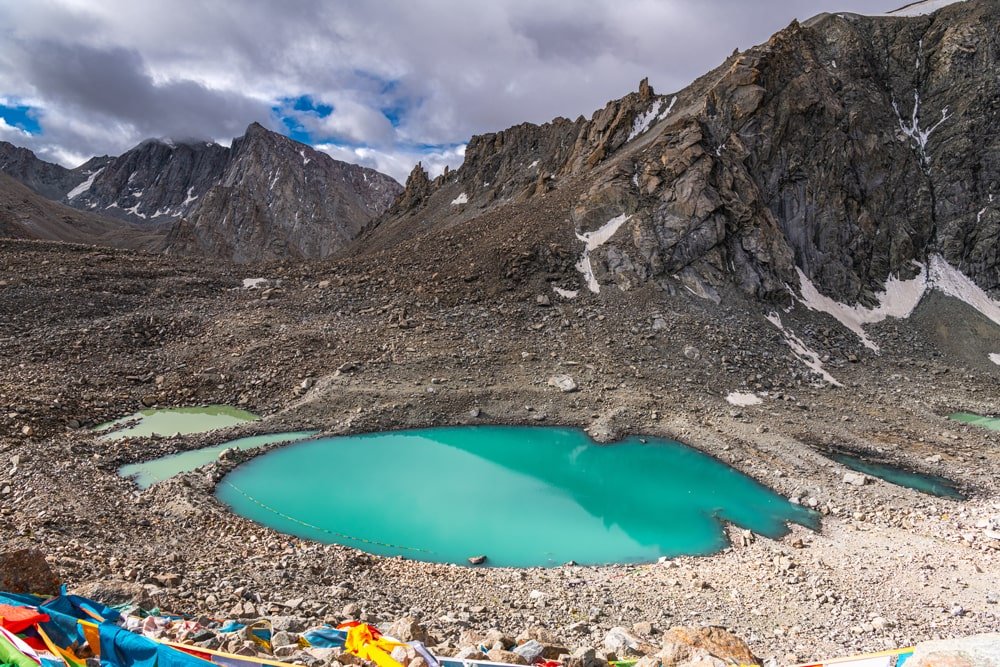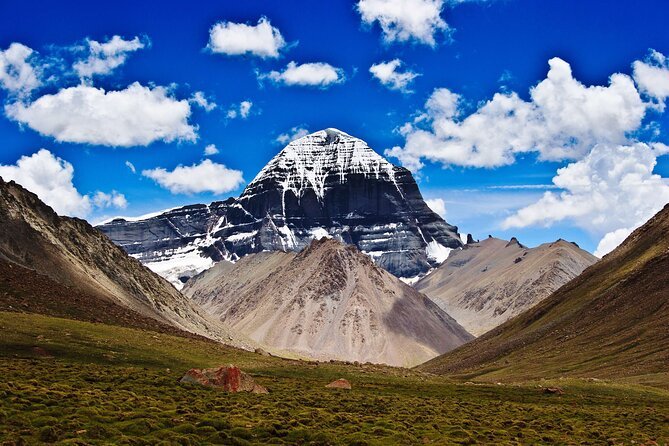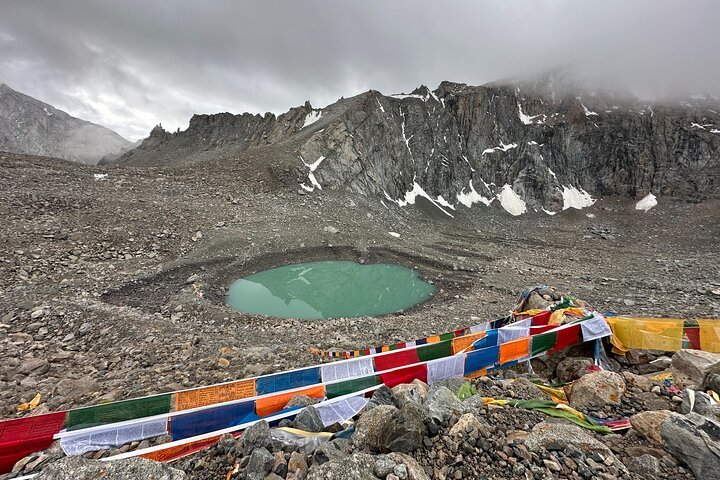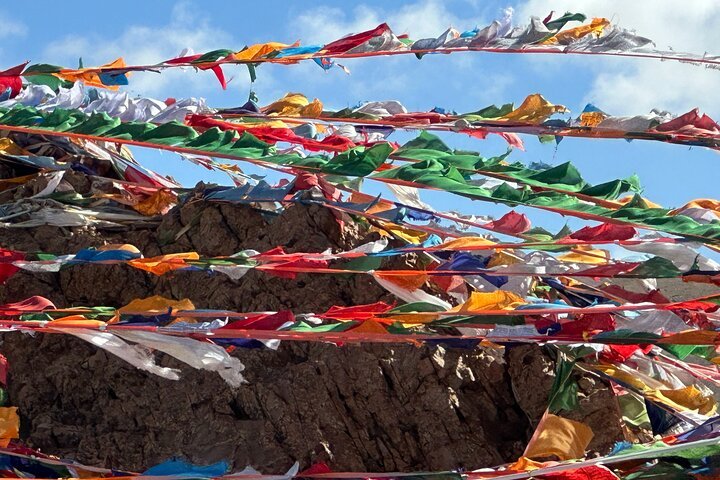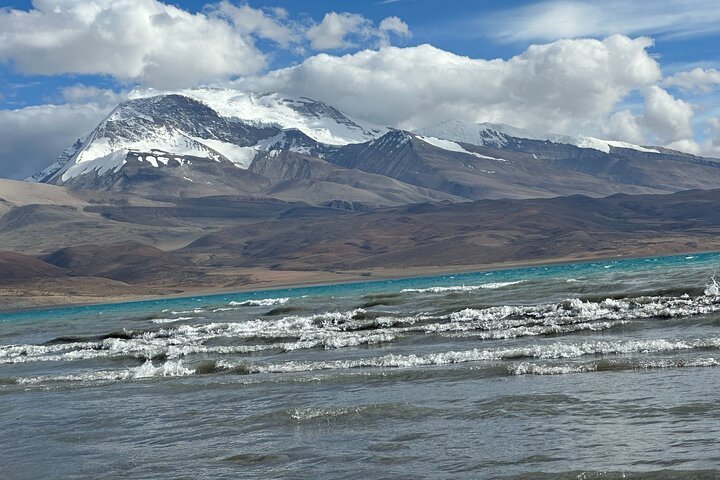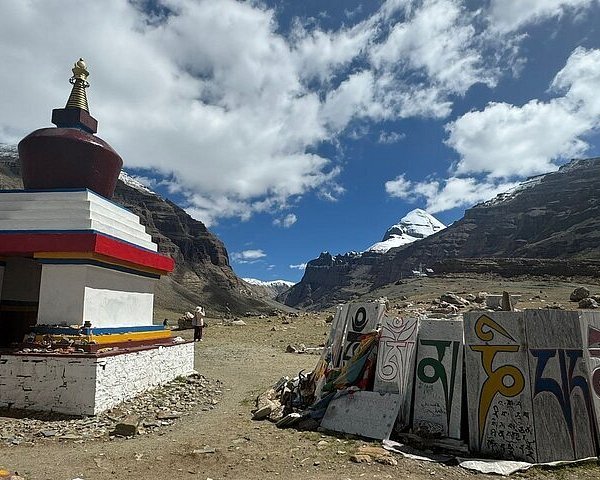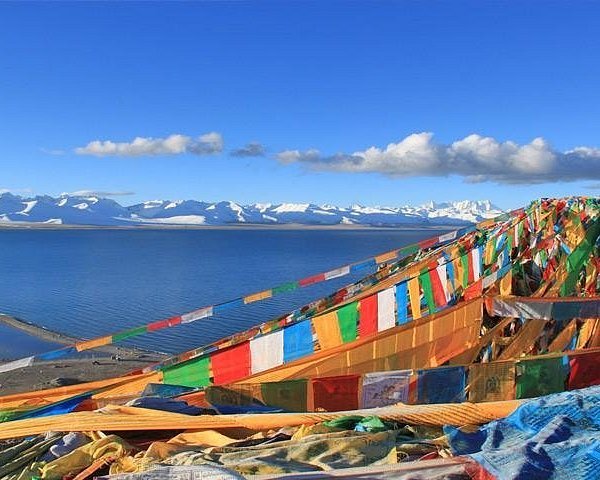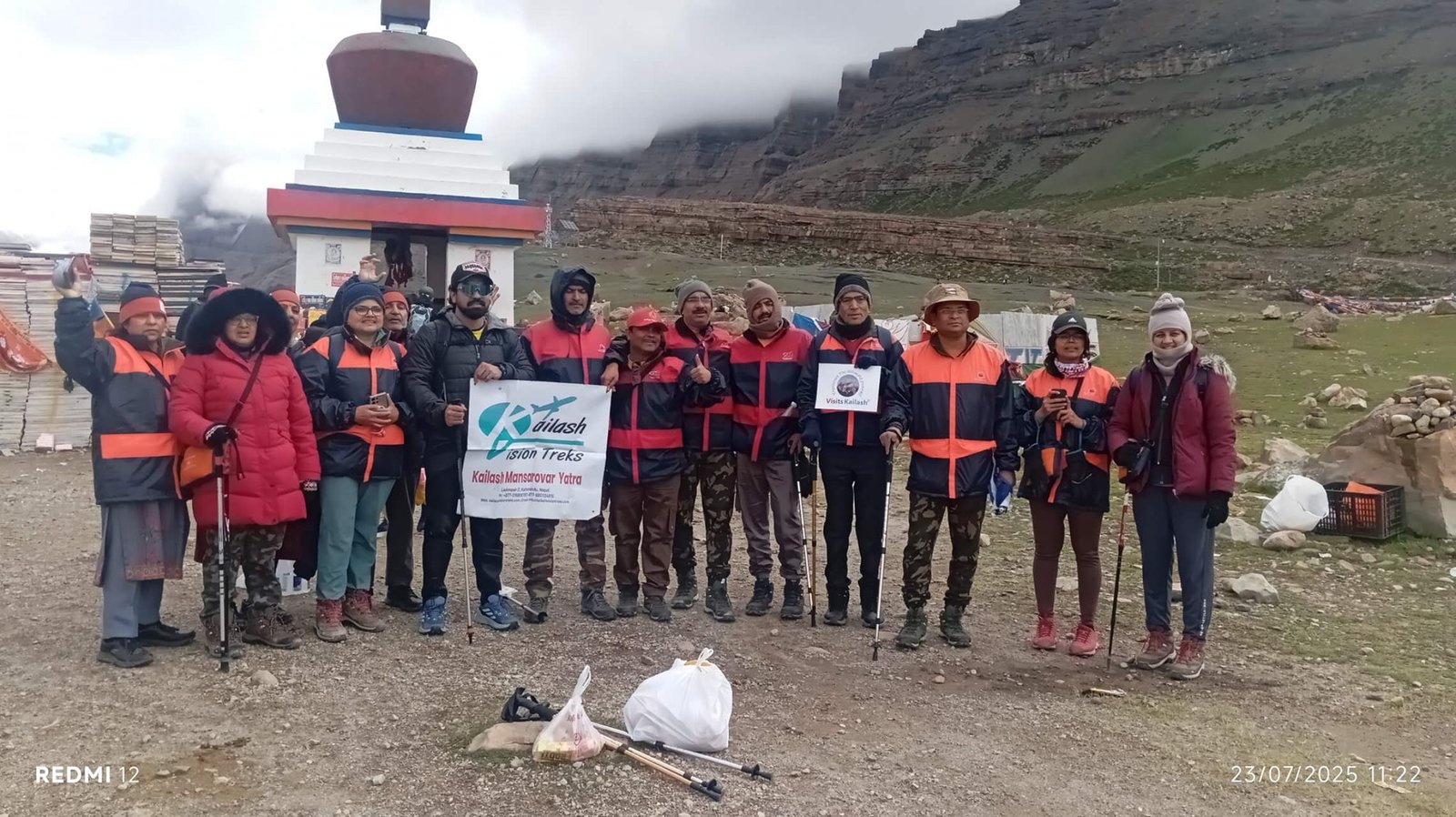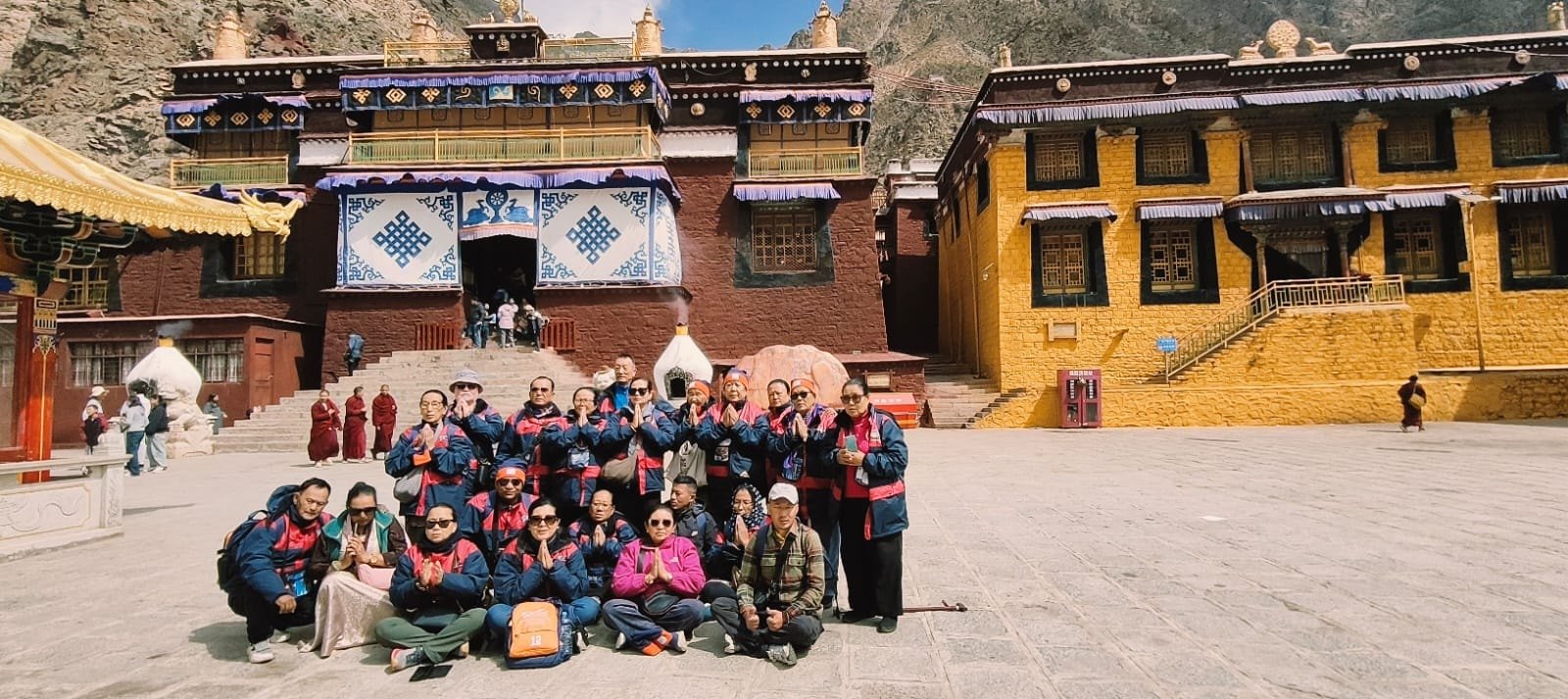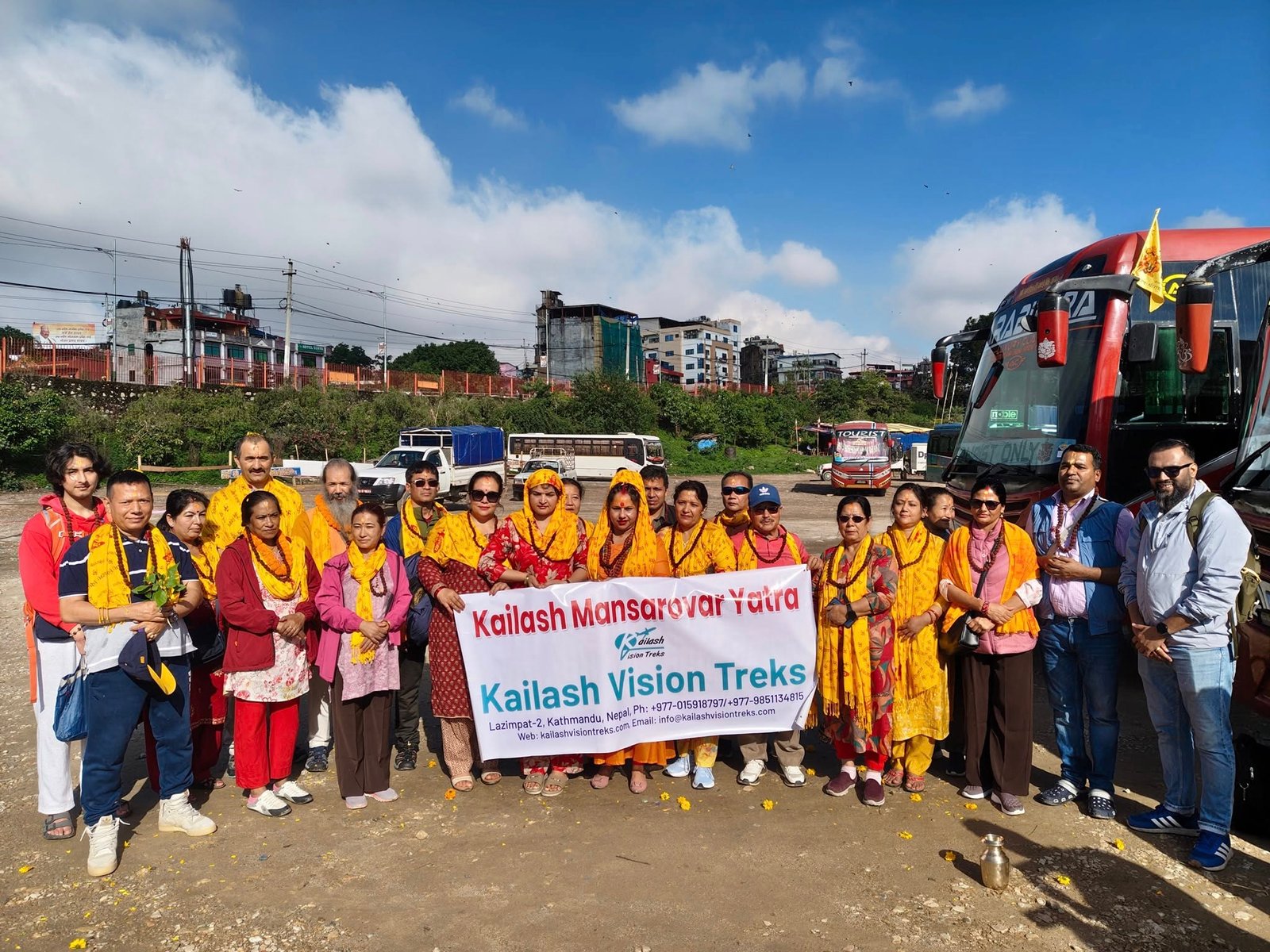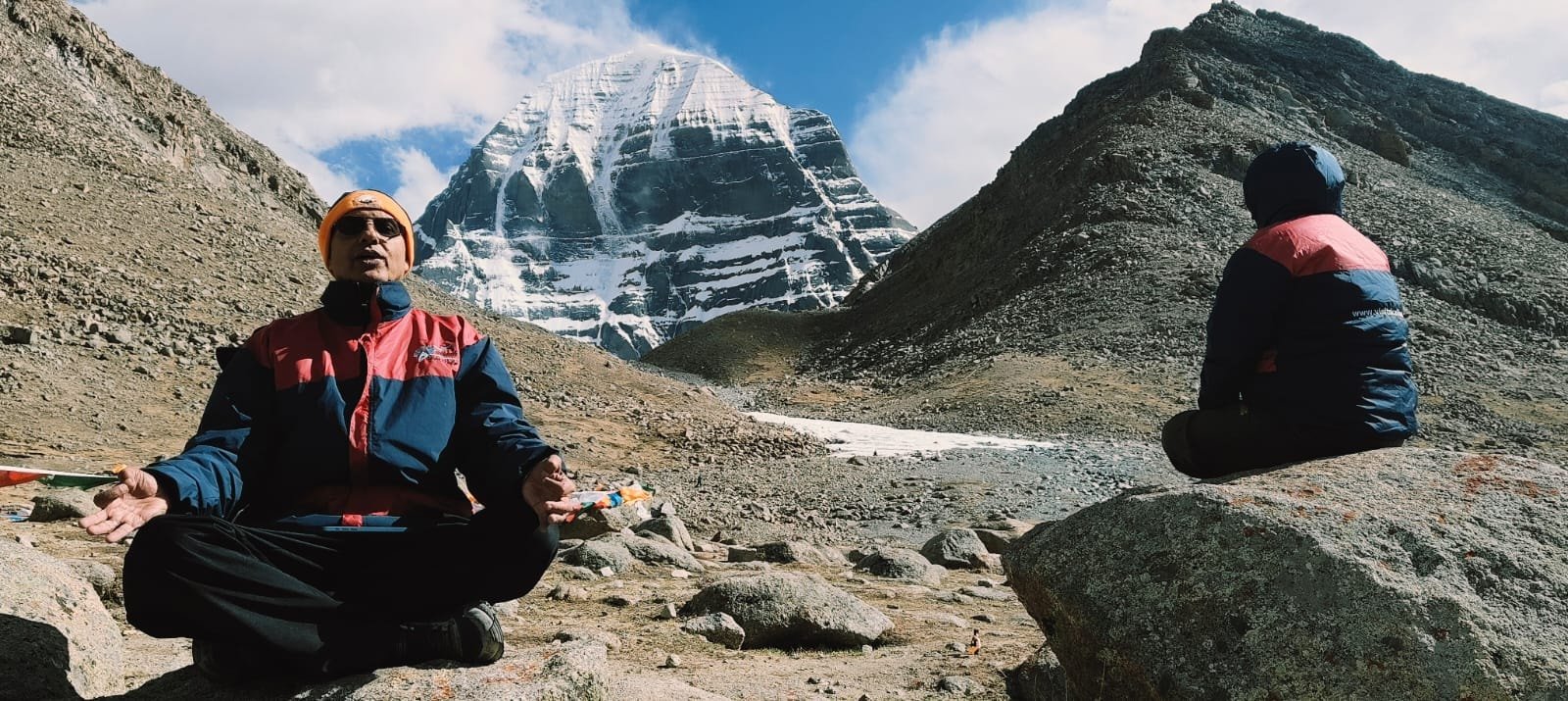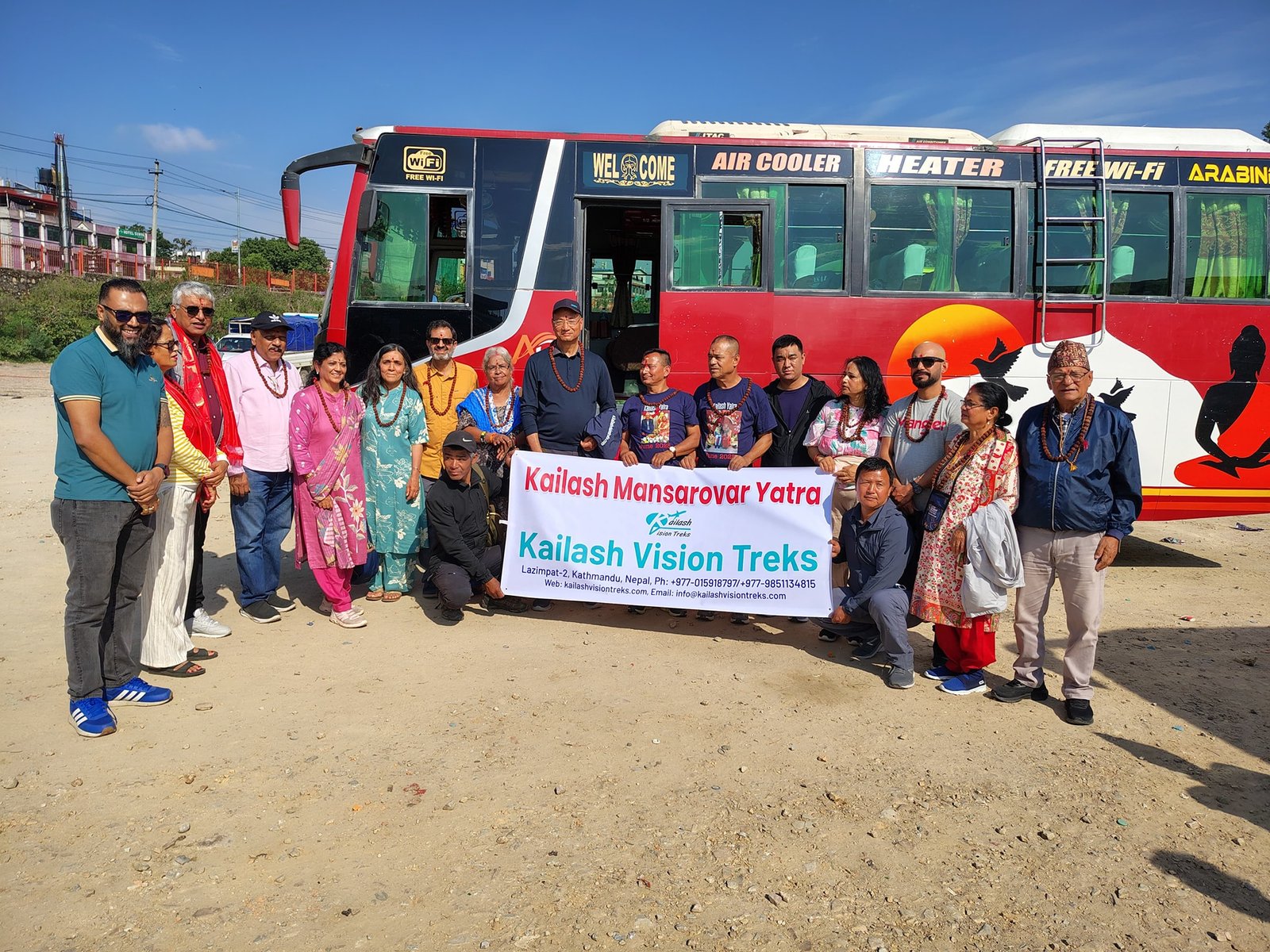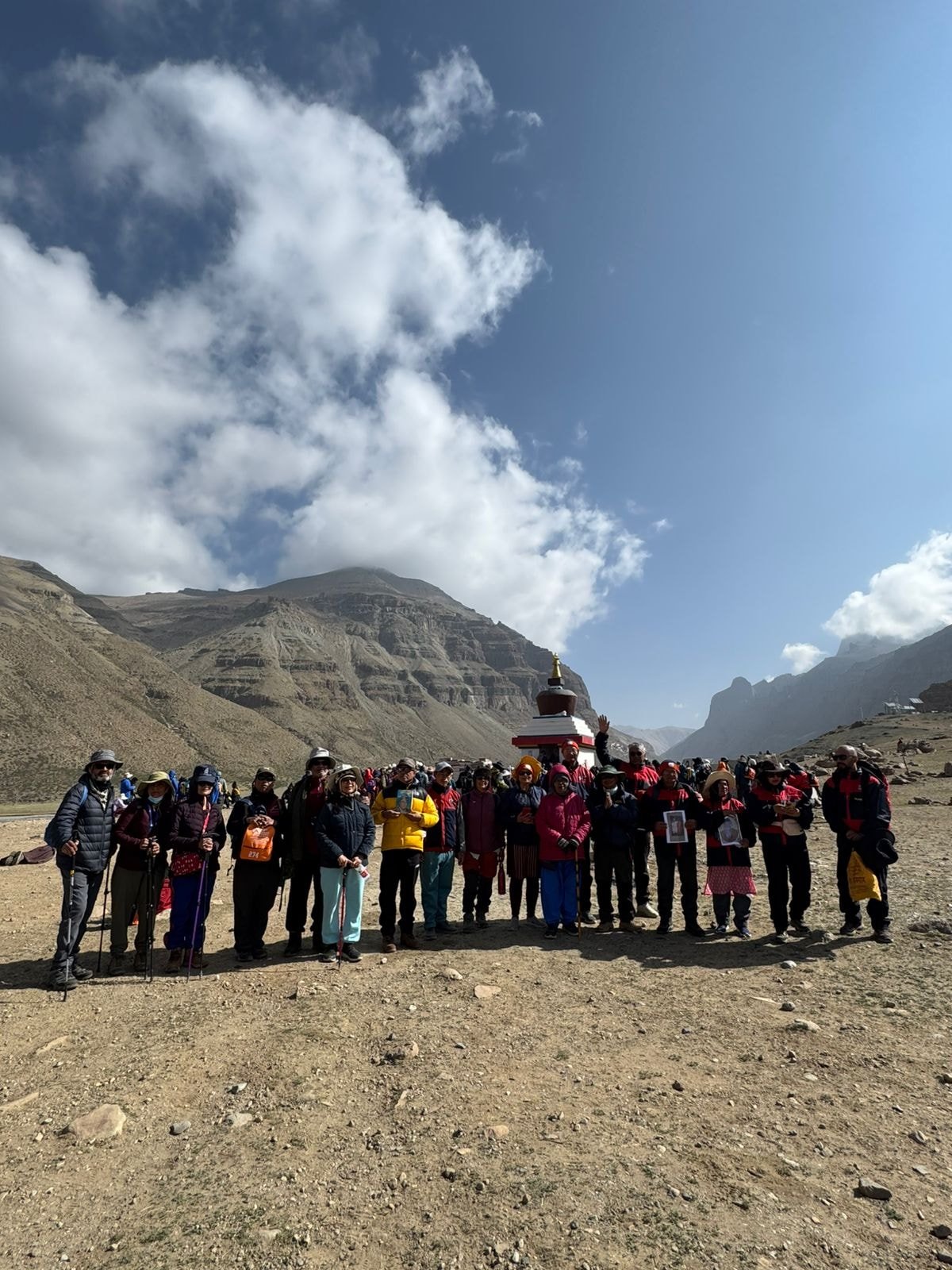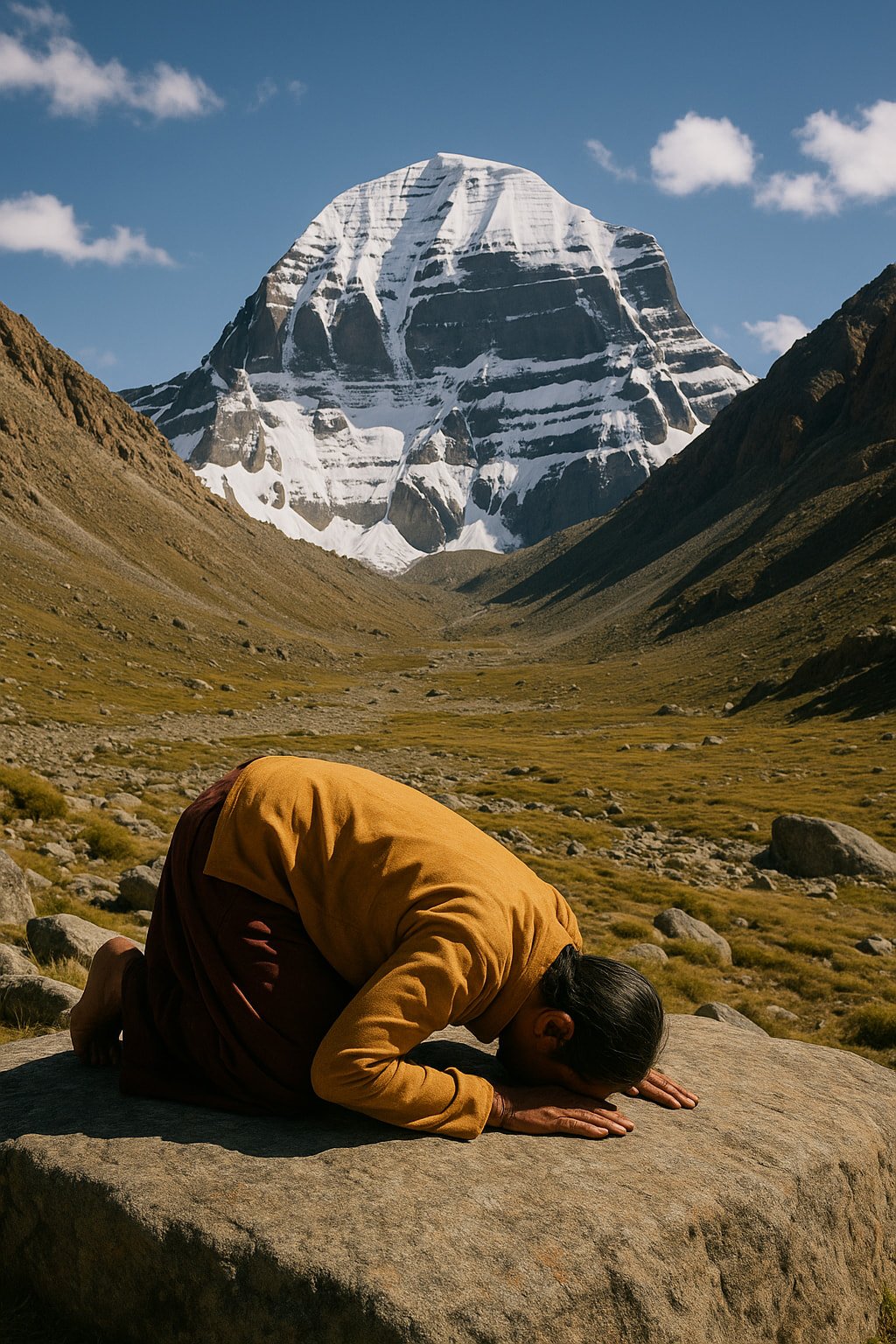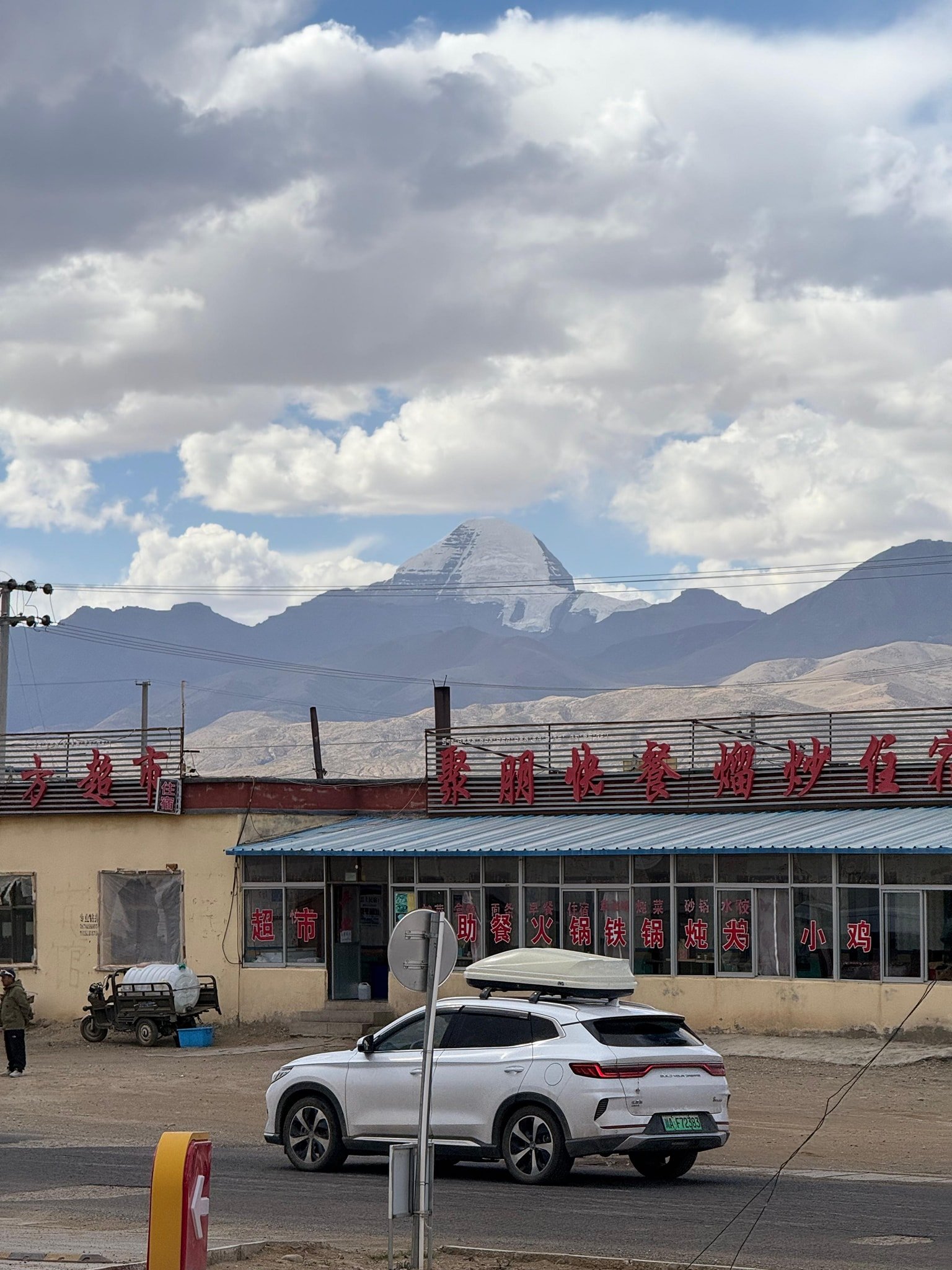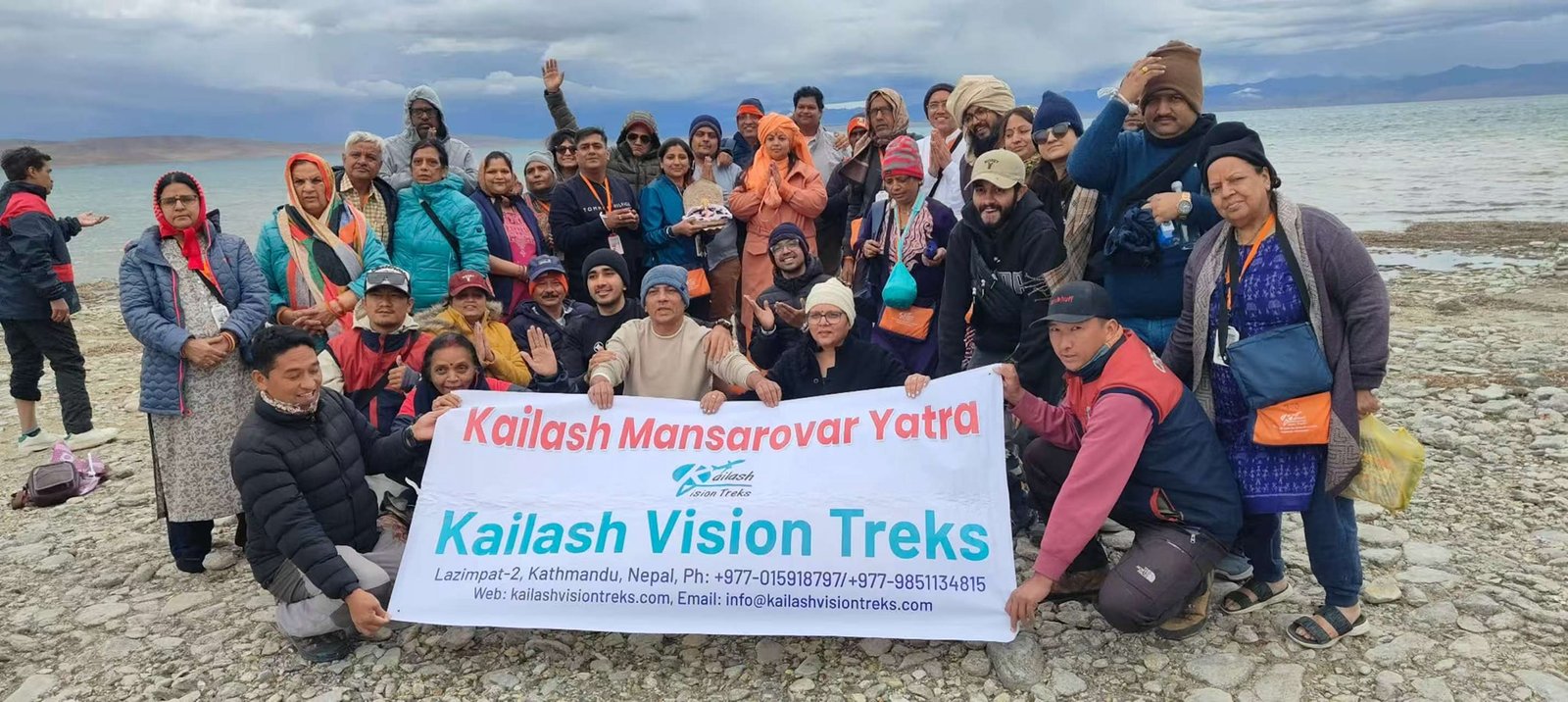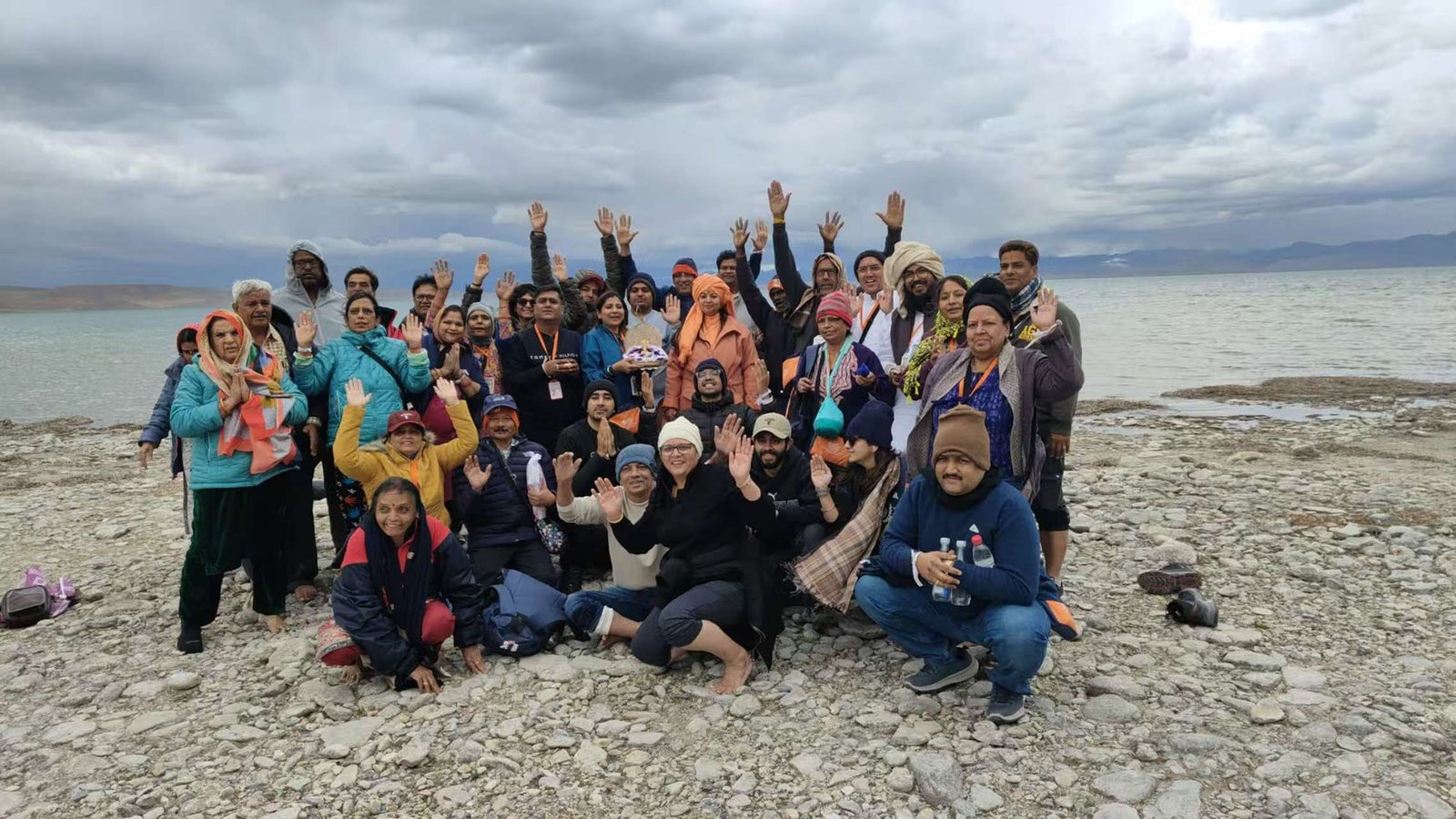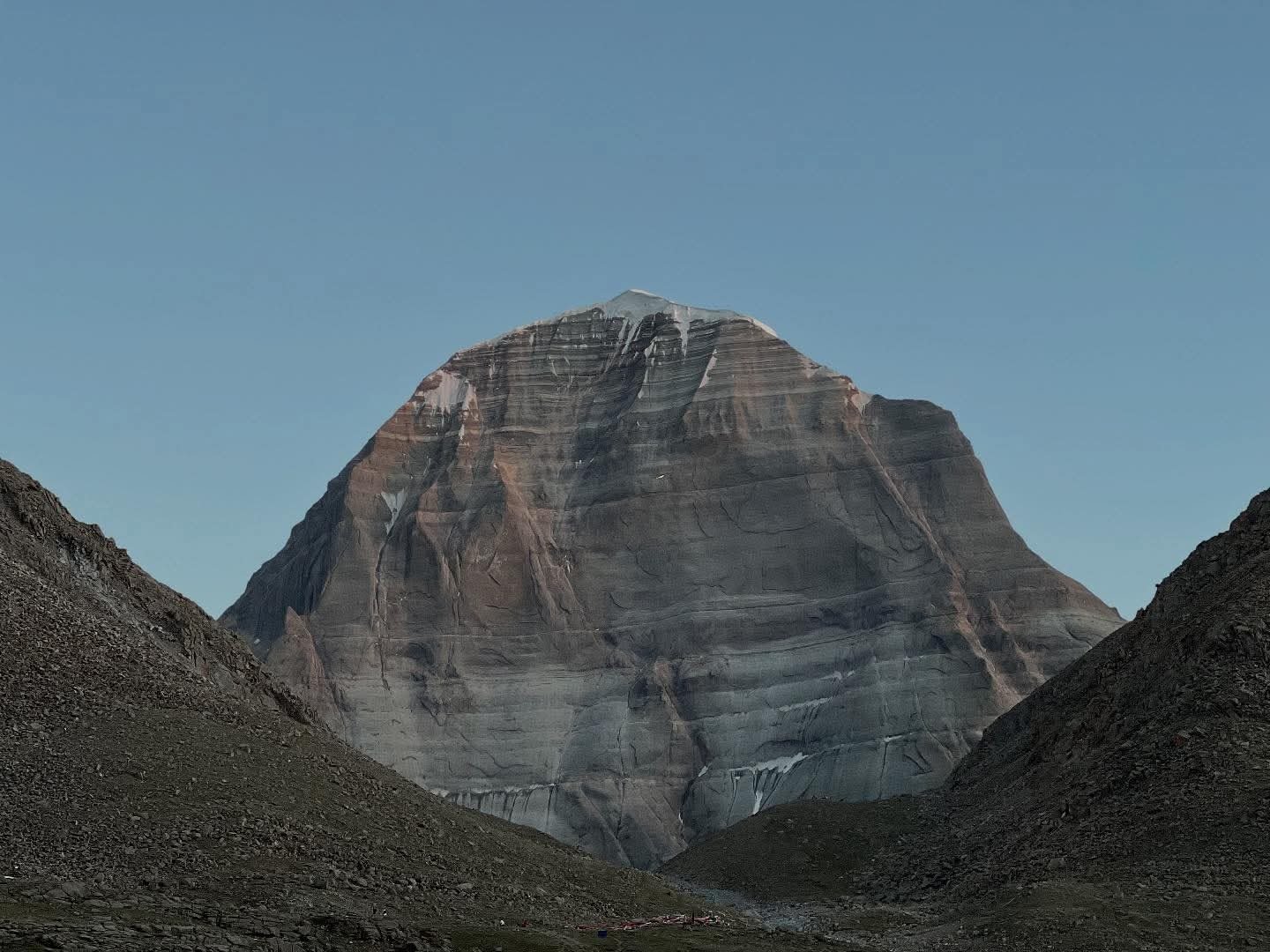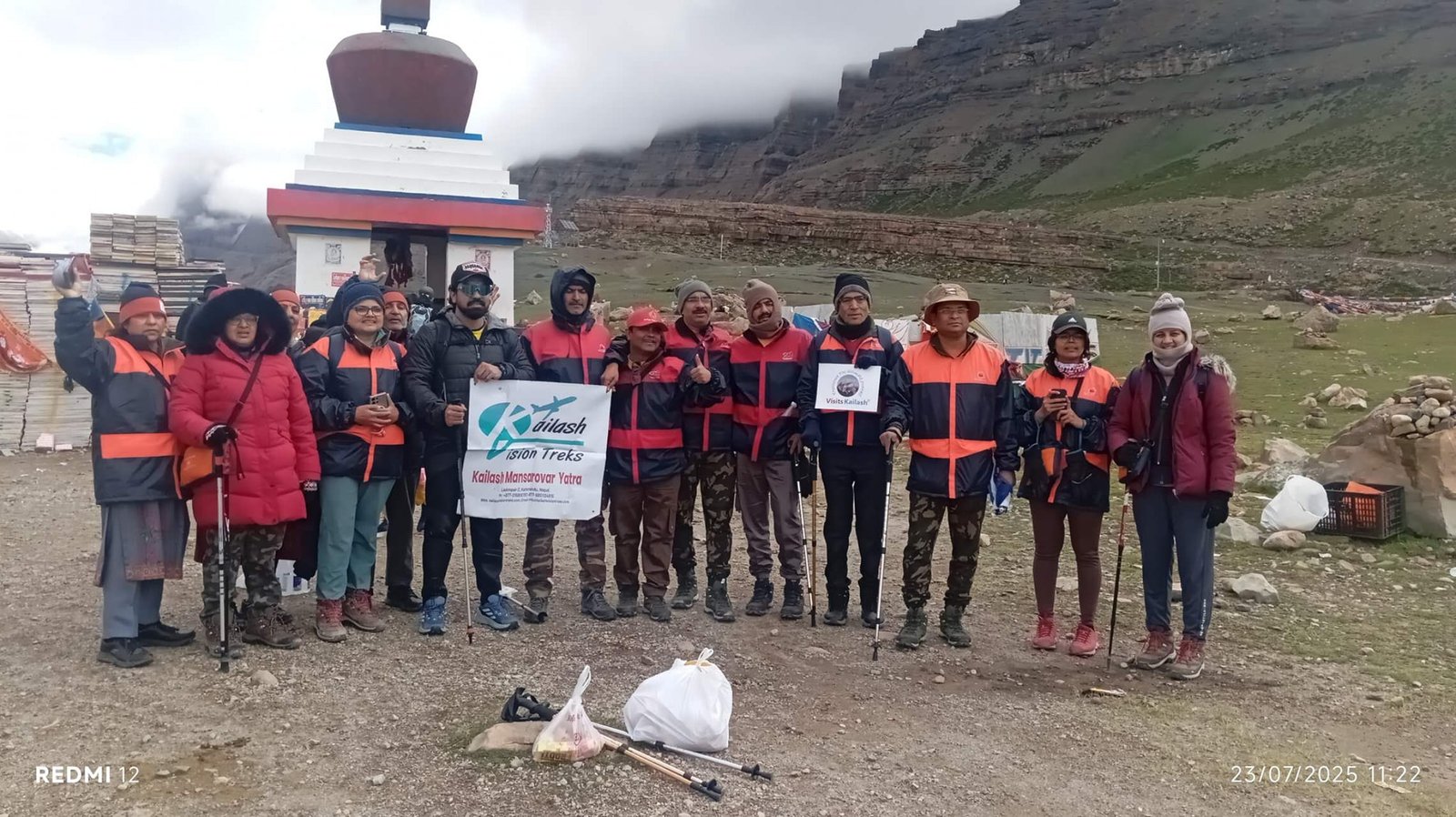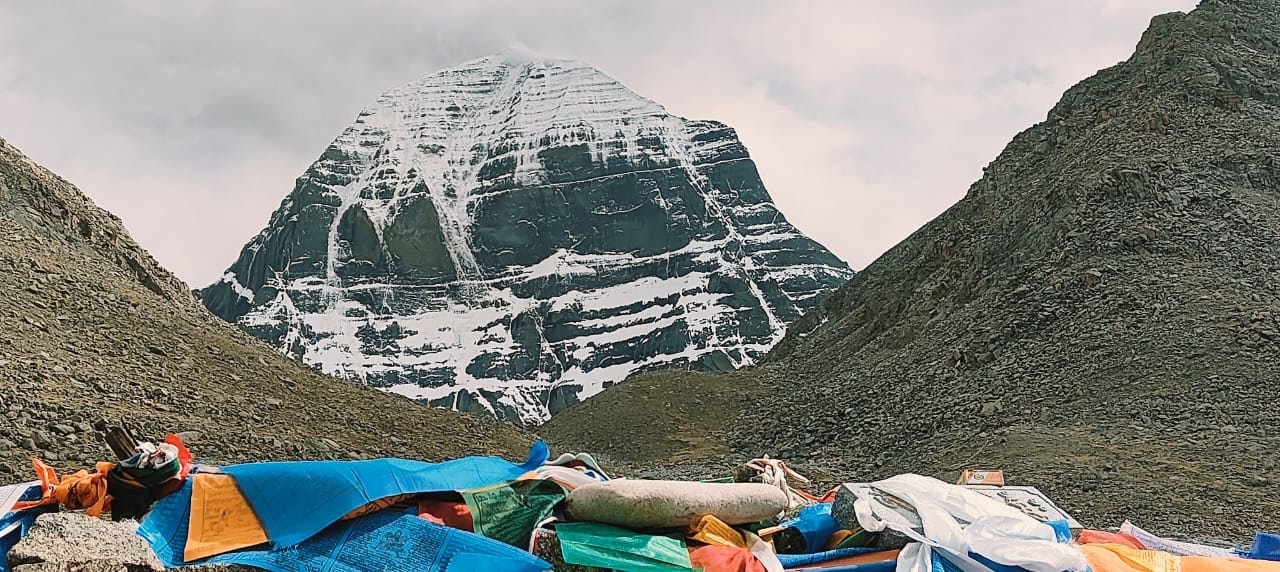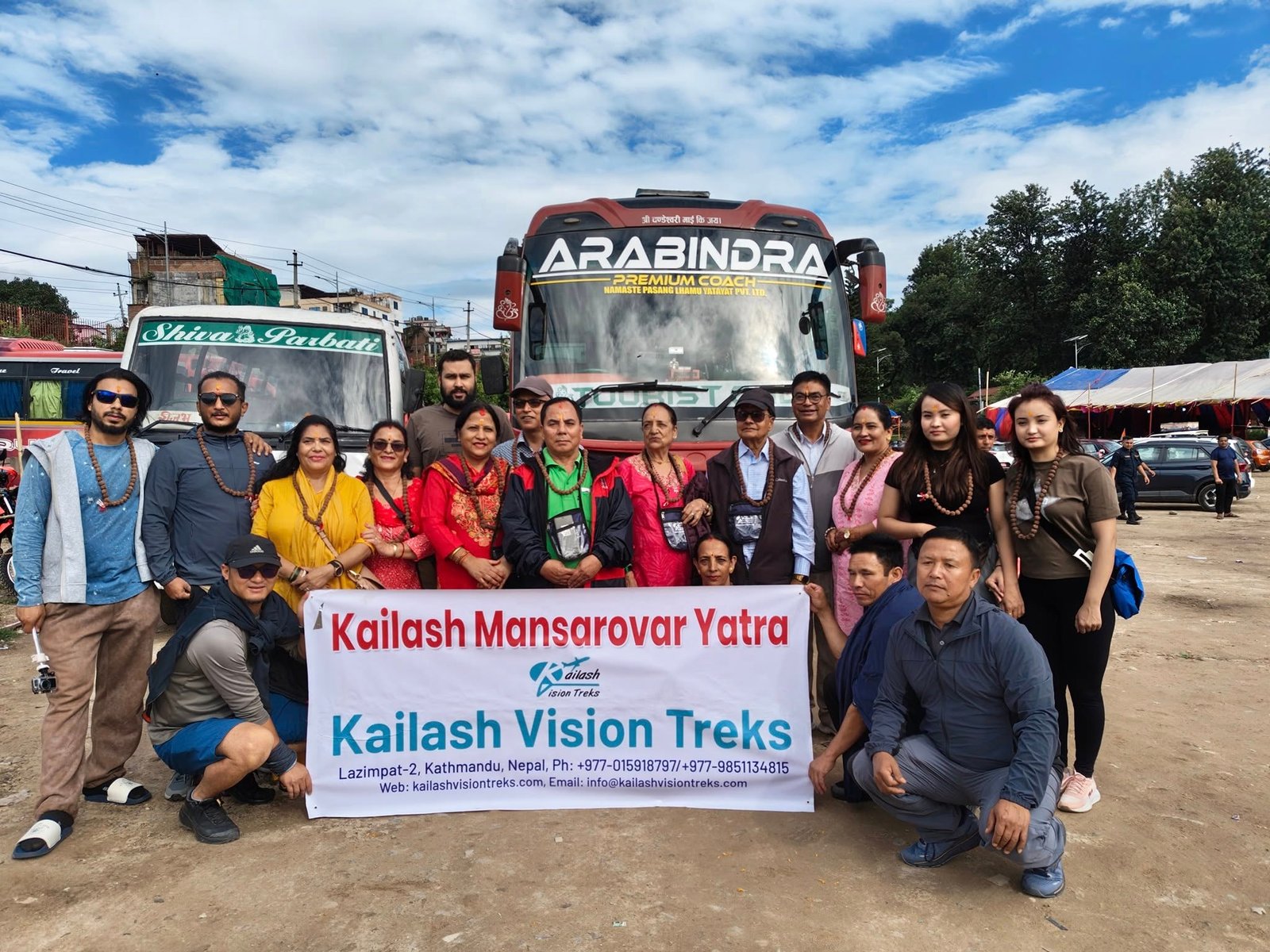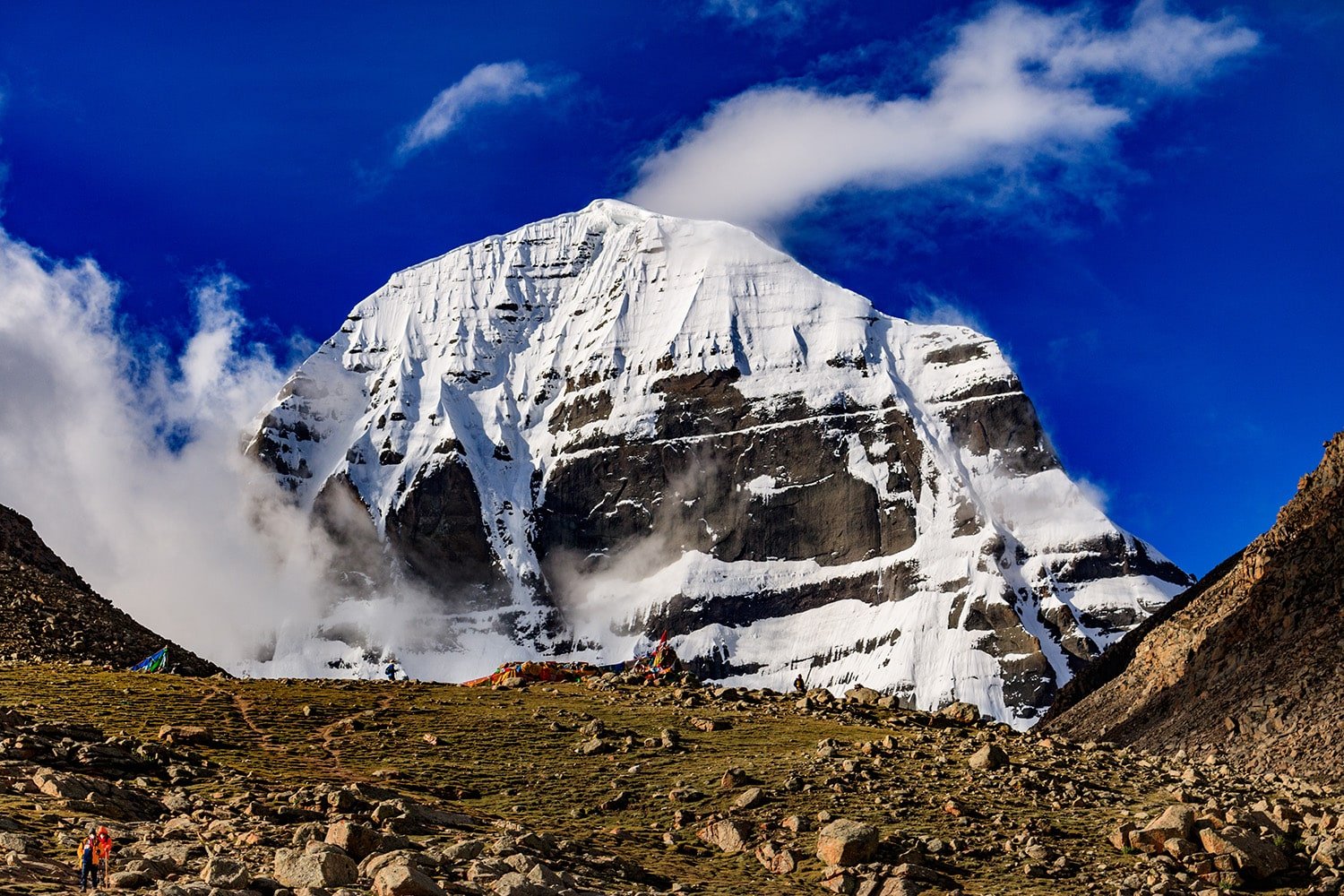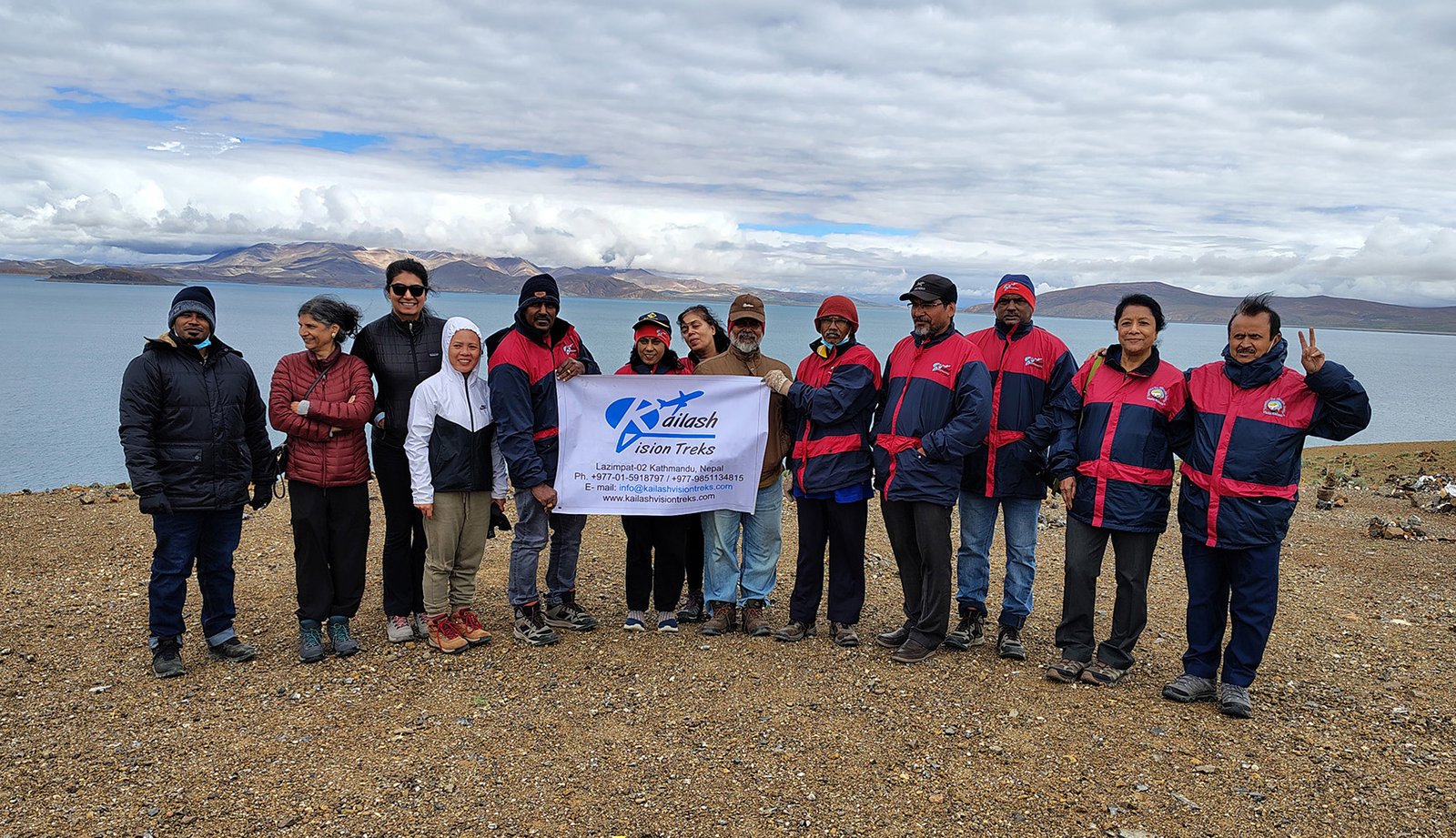Kailash Mansarovar Yatra – A Complete Guide
Table of content
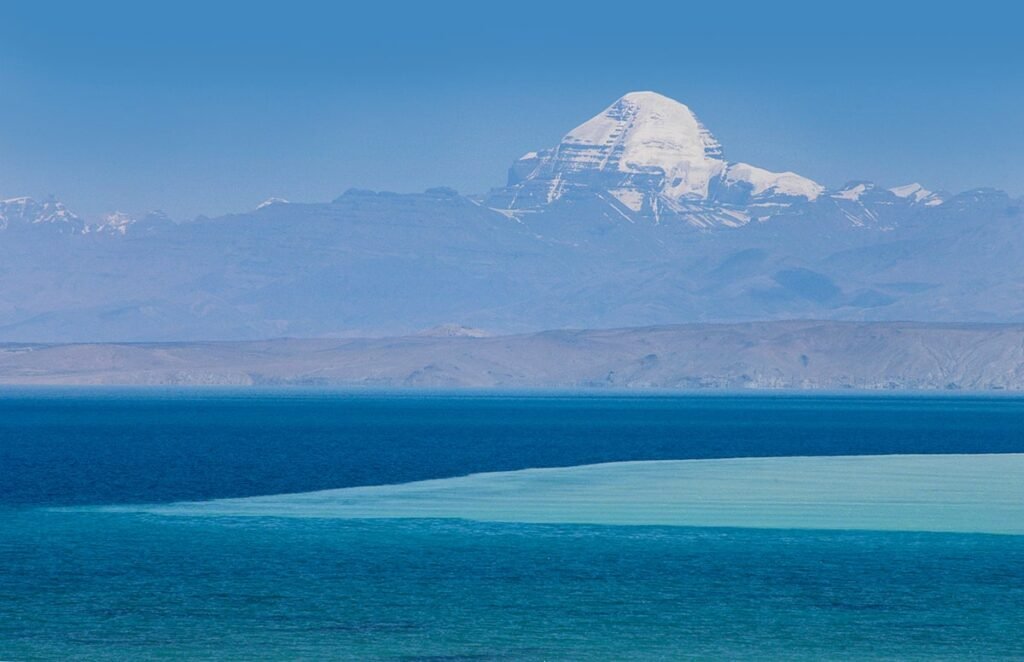
Mount Kailash
Nestled in the remote wilderness of western Tibet, Mount Kailash stands as a majestic pyramid of rock and snow, revered as one of the holiest places on Earth. For thousands of years, spiritual seekers have come here to find divinity, purity, and liberation from their sins.
Sacred to Hindus, Buddhists, Bonpo, and Jains, Mount Kailash is known as the “Navel of the Earth,” a place where divine energy is believed to touch the earthly realm. Pilgrims from around the world come to honor its sacred presence, performing the ancient ritual of Parikrama (kora) by walking around the mountain in deep devotion.
The journey is both challenging and transformative. As trekkers pass through surreal valleys and canyons, they experience a profound inner shift. This spiritual journey reaches its peak at Dolma La Pass, the highest point of the pilgrimage, where physical effort meets a deep sense of spiritual awakening.
History and Significance
Ancient texts depict Mt. Kailash as the center of the world. Within 30 miles radius of this snow-clad rock pyramid are the sources of rivers Indus, Sutlej, Brahmaputra and Karnali. According to holy texts of Hinduism, Mt. Kailash is the abode of Lord Shiva. Jains call Kailash as Mount Ashtapada. Rishabhadeva, the founder of Jainism is known to have attained liberation from rebirth at Mount Kailash.
- Hinduism: Mount Kailash is considered the abode of Lord Shiva and Goddess Parvati. Performing the parikrama (circumambulation) of the mountain is believed to cleanse sins and grant moksha.
- Buddhism: Buddhists regard the mountain as the home of Buddha Demchok, representing supreme bliss.
- Jainism: It is believed that Lord Rishabhadeva, the first Tirthankara, attained salvation here.
- Bon religion: Followers believe Mount Kailash is the seat of spiritual power and a central axis of the world.
The Lake Mansarovar, a pristine freshwater lake, is believed to have been created by Lord Brahma. A holy dip in its waters is said to wash away all sins and bring spiritual purity.
Visit Mt. Kailash
Pilgrims take on a tough journey to Mount Kailash, walking a kora – a 42 km trek that circles this sacred mountain. This guide is here to help you plan your spiritual adventure to Mount Kailash, known by Tibetans as Kang Rinpoche.
Major Challenges
The journey to Mount Kailash is not just spiritually meaningful, but also physically and logistically demanding. Traveling through high-altitude, remote routes requires both mental strength and good physical fitness. On top of that, reaching Tibet itself can be difficult for many pilgrims. This guide highlights the main challenges you may face and how to prepare for them.
1. Tibet Travel Permit
Getting the Tibet Travel Permit is one of the biggest challenges. The rules and regulations set by the Tibetan authorities often change, and the permit for Kailash Mansarovar Yatra can only be arranged through authorized travel agencies. Occasionally, permits may be delayed or entry could be restricted for reasons beyond anyone’s control, though this is rare.
2. Lack of Basic Services
The route to Mount Kailash passes through some of the most remote areas of Tibet. While travel agencies arrange accommodation, transportation, food, and water, basic services like mobile networks, internet, and health facilities are often unavailable. During peak times like full moon departures, accommodation can also be limited due to the few guesthouses in the region.
3. High Altitude Trekking and Weather
The kora (trek) around Mount Kailash is done at an altitude of over 4,000 meters. The combination of thin air, steep paths, and unpredictable weather makes this a tough challenge. High altitude can cause health issues such as fatigue or altitude sickness, so proper acclimatization and preparation are essential.
Preparing for the trip
The most challenging part of the journey is making the kora, and you need to be well prepared to overcome these challenges. The kora starts at Yama Dwar, 08 km away from Darchen, the base camp of Mt. Kailash.
Step 1: Understanding Your Destination
Climate
The journey to Kailash will take you through various circumstances. Dealing with the climatic variations throughout the journey is one of the most challenging aspects of this journey. This journey requires you to prepare for extreme cold circumstances as you will be trekking through snow covered, dry and windy terrains.
The temperature variation will be between -5 to 20 degrees Celsius. At night it gets chilling cold. During the day, if the Sun is out, it gets around 15 – 20 degrees. Make sure you pack enough warm clothes for these circumstances. Despite the routes, you will have to travel on a bus at one point or the other. Since you will be travelling in large groups, it is going to be stuffy inside. Make sure your clothes are warm yet light. Packing clothes for multiple layers is highly recommended
Altitude
During the kora, you will have to trek at altitudes higher than 5000m. It is not recommended for you to visit Kailash if you are epileptic, or are prone to seizures. Even if you are not doing the kora, you will have to travel to altitudes higher than 4500 m. Make sure you are in an excellent health condition before making this trip. Make sure that your travel agent/agency provides you with oxygen supply under emergency conditions. Pack up medications related to health risks one can face at high altitudes for emergency situations.
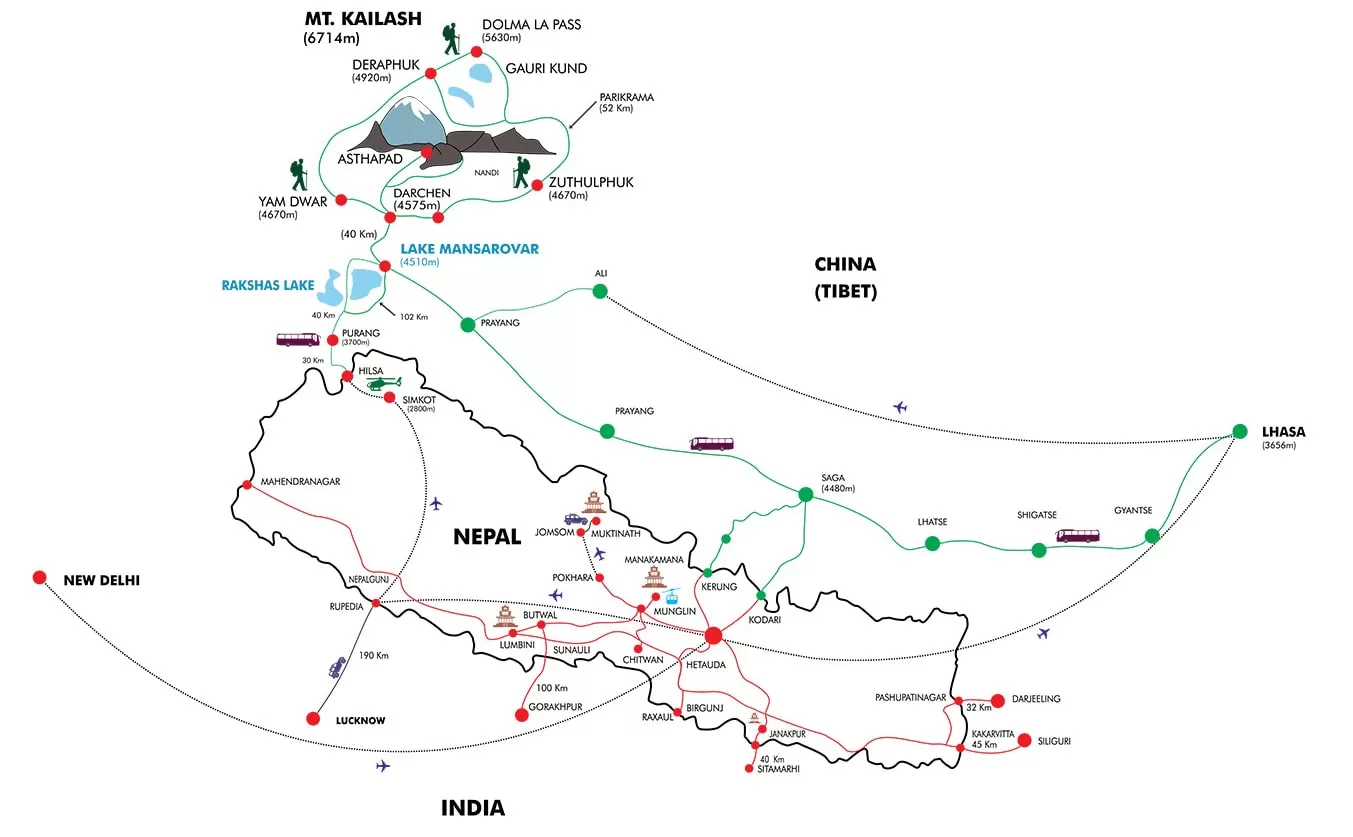
Step 2: Planning The Routes and Dates
Mt Kailash can be visited through Nepal and India.
Through Nepal
Going to Kailash through Nepal, only Kailash tour operators affiliated with T.A.R. Foreign Exchange Center (FEC) will be able to apply for the permits for the trip. Previously China India Pilgrim Service Center (CIPSC) who used to handle all the Indian Travelers has been closed and a new organization named as Foreign Exchange Center (FEC) has been established to handle the groups starting 2019. As per their requirements, only after sending the Authorization Guarantee Deposit amount to FEC, one can obtain the certificate to apply for the permits and only those companies will be able to operate the trip in collaboration with them. We inform all the travelers, before booking to ask your travel agent whether they have obtained the authorization certificate or not.
Nepalgunj – Simikot – Hilsa in Nepal route
This is a popular trekking route to reach Mt. Kailash. You can either trek to Hilsa or take a helicopter. Taking a helicopter is quicker and convenient but is comparatively expensive. Through this route, if you take the helicopter, the trip to Mt. Kailash along with the kora takes under 11 days. If you want the trip to be quick, comparatively convenient and spiritually fulfilling, this route is strongly recommended.
Best time to go: May, June, September (July-August tours may be influenced by the monsoon)
Kathmandu – Kyirong – Saga
This is an overland route for the journey to Mt. Kailash. The journey will be around 13 days long on Coach / Bus until Darchen. However, this route is cheaper than the Simikot – Hilsa route despite taking more days to complete. If you want your trip to be more affordable this is the way to go.
Best time to go: May- September (Depends on road conditions)
Private Helicopter Charter
This helicopter charter is another option to visit Mt. Kailash. This will definitely be highly expensive, however will allow you to highly customise your own trip. A 5-person group is recommended if you want maximum economic efficiency, regardless of the number of people, the cost of chartering the helicopter is fixed.
Best time to go: May- September (Independent of Weather)
Through India
Facilitated by the Indian Government only for Indian Pilgrims, a 28 days journey to Mt. Kailash is organised each year in the summer months. This journey takes you through other various religious sites in India, trekking for more than 20 days through the Uttarakhand border.
Pilgrims are required to apply for this program. The application is a rigorous process. Over 6000 pilgrims apply to travel to Kailash through this route and only as many as 400 get selected every year. Even if you are applying in a group, it is not assured that all the members of the group will be selected.
Step 3: Obtaining the Permit/Visa
As per the rules of the Chinese government, it is a must that the travellers apply for the permit through an authorised travel agency. Processes of applying for the permit varies for Indian travellers and for Non-Indian travellers. The travel agency applies on behalf of the travellers in group, as required by the Chinese regulations. Hence, the travel agency set the dates for travel as they will be dealing with multiple people to create a group large enough to apply for a group visa.
First, the travel agencies require you to fill up a booking form purchasing package. On accounts that you are travelling in a large group (numbers may vary between travel agencies), you can also request for a customised trip and select the date of travel.
For Non – Indian travellers travelling through Nepal
The Tibetan permit application process requires you to send colour-scanned copies of your passport through which the travel agency will apply. The time required for the permit to be granted by the Tibetan authority is not fixed, but it generally takes around 25 days. Later you will need to arrive to Kathmandu 03 working days before the trip in Kathmandu for the Chinese Visa as we will require your original passport. You can get a Nepalese Visa upon arrival at Kathmandu Airport.
For Indian travellers travelling to Kailash through Nepal
you will be required to send your coloured copies of the passports to the travel agency, through which they will apply for the permit on your behalf. Later we will require your original passport at our Delhi office about 07 working days before the trip date for the Chinese Visa. Generally, your passport can be collected from Delhi once the visa is approved. However, since Indian citizens do not need a passport to travel to Nepal, you can travel with your Voters card to Kathmandu if flying directly from India. If you travel by road then any valid government Id will do. You can also pick up your passport once you arrive in Nepal.
Note: Regardless of you having a valid Chinese Visa already stamped on your passport, you will still be required to apply for a Chinese Group Visa if you are travelling for Kailash through Nepal. The existing Chinese Visa will be cancelled by the Chinese Embassy and new Group Visa will be provided.
Age Limit
As per the new rules, the age limit has now been removed and Indian travellers above 70 years of age will also be able to join for the trip but there are certain requirements for it. The requirements for such travelers are as mentioned below:
- You have to submit health examination report made within 6 months from travel date by Indian public hospital above the country level, the content of the report should include the doctor’s judgment and suggestion whether your physical condition is suitable for the plateau area (4000 meters or 13000 ft above sea level).
- Application by you to express the intention for pilgrimage in Tibet side; the application should be signed and fingerprinted by you and your two direct
- Tibet side will judge whether to allow your entry according to the documents
- You should not have high blood pressure, heart disease, asthma and other
- At least two of your relatives should accompany you on the
- Also you have to pay USD 1000 as a risk deposit to A.R. Foreign Exchange Center (FEC) which will be returned back after tour completion except, If incase a pilgrim died then the deposit will be charged as liquidated damage by T.A.R. Foreign Exchange Center (FEC).
- Local medical center of Tibet will make health examination and give a proposal whether you are suitable for parikrama. If doctor’s proposal is “not suitable for parikrama” you have to stop the
For Non-Indian travelers, the above mentioned formalities are not necessary.
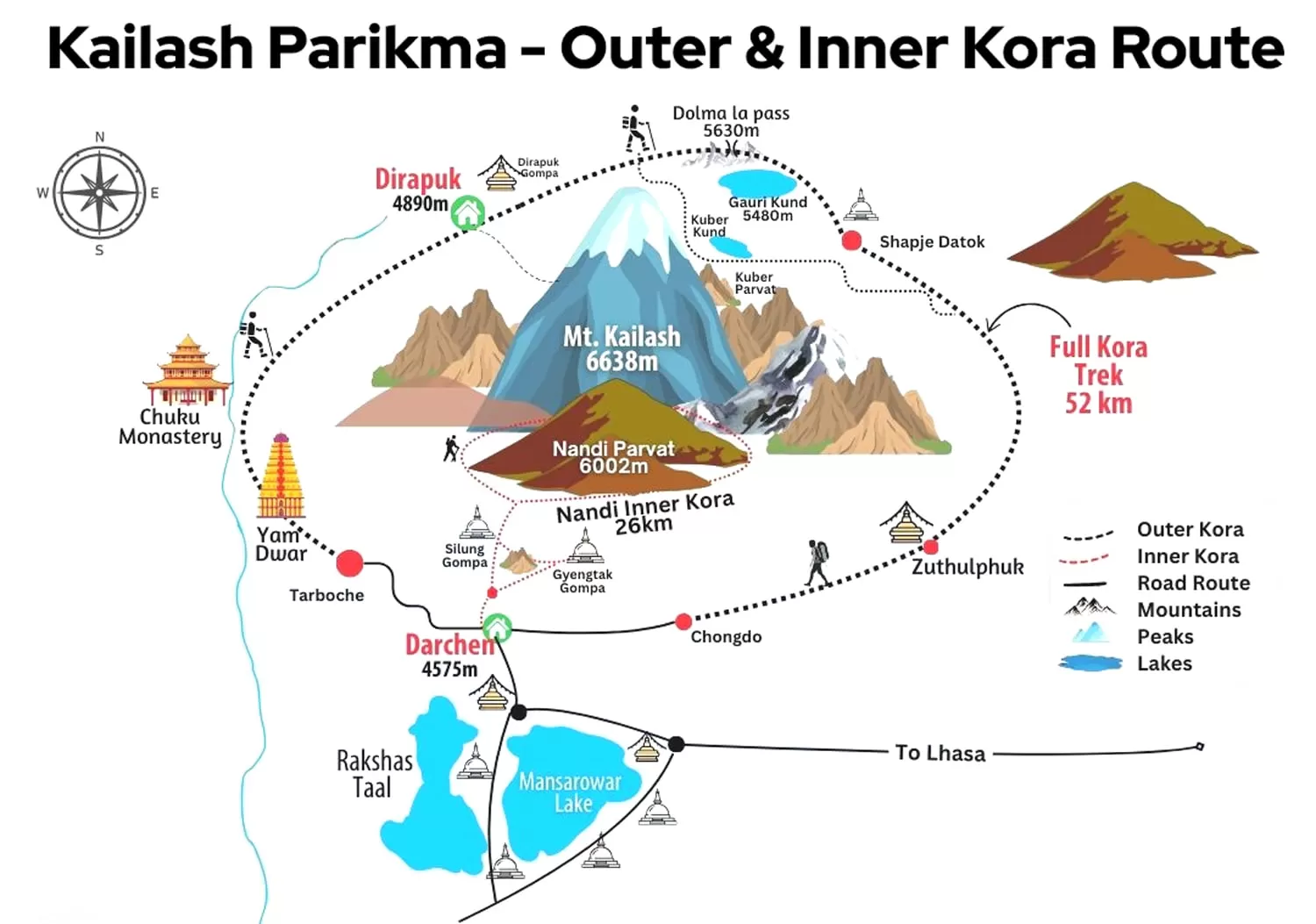
General Itinerary During Kora
The kora begins at Yama Dwar, which is 2hrs drive from Darchen, the Base camp of Mt. Kailash. The kora is generally 3 days long. This is the common itinerary during kora.
1st Day of Parikrama
- Drive to Darchen (4650m) & Yama Dwar & Trek to Dirapuk (4880m) – Overnight in Dirapuk After Breakfast – Drive to Darchen (35 km – 1 hr) and Yama Dwar (8 km) – the starting point for Kora.
- We will trek to Dirapuk for 14 km. You will visit the North face of Mt. Kailash and touching the feet of Mt. Kailash (Charan Sparsh). Travelers who do not want to trek around (Parikrama) Mt. Kailash can go back to Darchen wait for the rest of the group to arrive from Parikrama.
2nd Day of Parikrama
- On to Zuthulpuk (4670m) via Trek to Dolma La Pass (5700m) – Overnight in Zuthulphuk After Breakfast – Trek from Dirapuk to Dolma La Pass (8 km).
- About 3 kms before reaching Dolma La Pass is steep hill and quite difficult to walk. Also descending from Dolma La Pass is the same for upto 3 km. While descending you can see Gaurikund on the right. After walking for about 2 – 3 hrs we will reach Phedi. After some rest we will start trek to Zuthulphuk (12 km trek for 6 hours).
3rd Day of Parikrama
- Trek to Darchen – Drive to Hilsa or Saga depending upon the package.
- After Breakfast – After short easy Trek (8 km – 3 hrs), we will reach our Private A/C Coach pick up point. Then drive to Darchen (3 kms) and merge with other members who were waiting. From there drive to Hilsa or Saga depending upon the package the travelers have booked.
Currency
For your travel, you need to manage your currencies and know where to exchange the currencies. The following are the important details to get around with exchanging currencies:
- You can ask your travel agent to exchange the amount to Yuan (Chinese Currency) for you upon your arrival in Kathmandu.
- It is suggested to carry minimum CNY (Chinese Yuan) 2,000 extra for any emergency and personal, if you want to hire a horse for Parikrama then extra 3500 needs to be carried.
- Any unused CNY may be re‐exchanged in Kathmandu.
Potential Extra Expenses
Ponies
Trekkers can hire ponies during the kora to ride ponies in case they are unable to walk. However the rule of the Pony owner and Porter Union is that Pony and/or Porter can be hired for full three days and not partial trip. Also the money has to be paid in advance and no refund is possible if you cancel the Parikrama or return back in two days time instead of doing the full three days Parikrama.
There are very slight chances that you may be able to get a pony for a single day in certain cases but the prices are definitely going to be exorbitant.
Emergencies
You never know when you will get into an emergency situation. It is always safe to have some amount with you if you get into any kind of trouble.
Mobile Phone in Tibet
How to keep in touch with your friend & family during the trip?
Indian and Nepali SIM card doesn’t work at Tibet side but there will be shops at the phone center on the way to Kailash Yatra. You can take your mobile with you and buy a SIM card there to keep in touch with your family and relatives.
Buying a Tibetan SIM Card
Costs: Yuan 100 – Only Incoming, Yuan 200: Both incoming and outgoing). Carry a cell phone and chargers. Recharge facilities available at lodge only during evening generator hours (3-4hrs).
Other En-route Attractions
During your journey to Kailash, depending on your route, you can enjoy various other attractions as well.
Pashupatinath
Joining the trip from Kathmandu you will surely be taken to visit Pashupatinath, one of the Holiest and Sacred Hindu temple which lies in the Eastern part of Kathmandu.
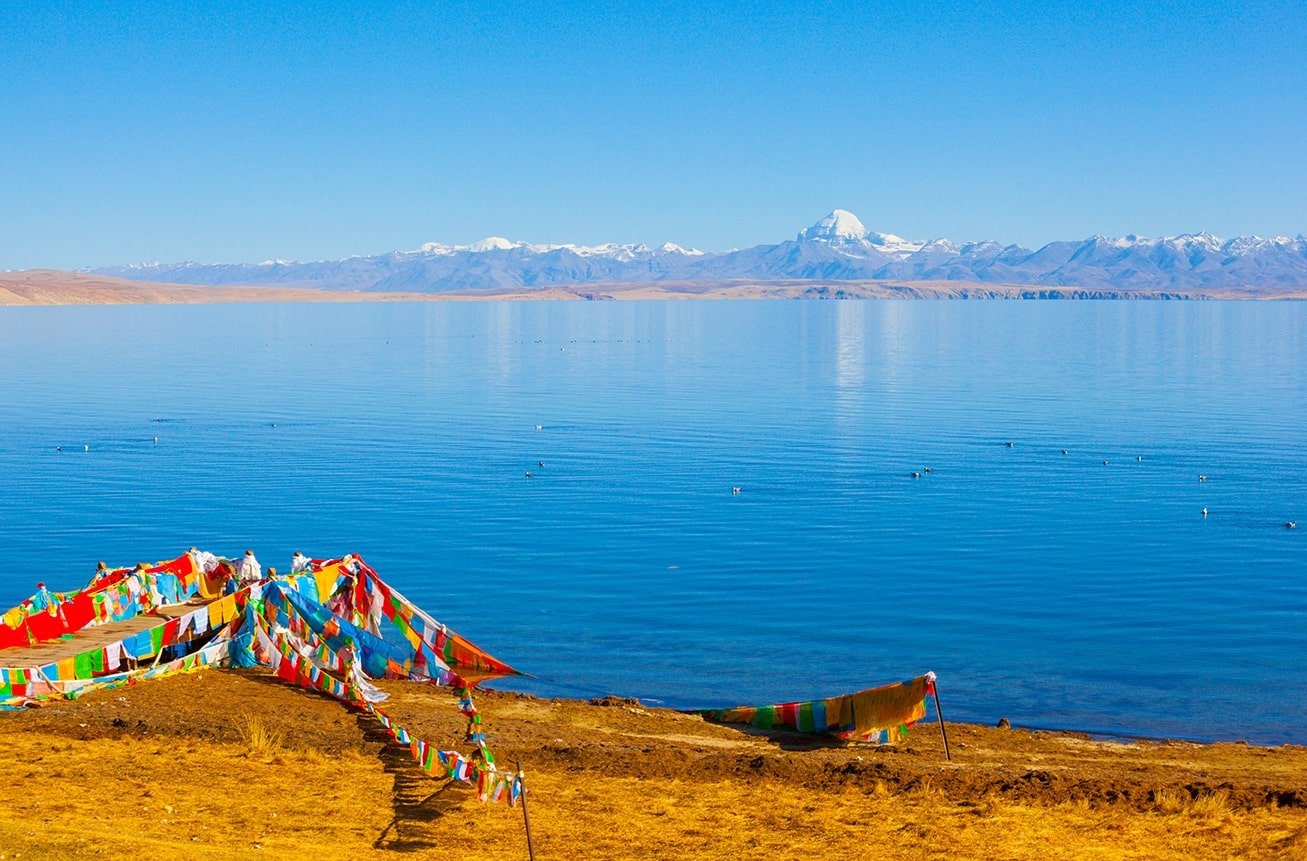
Lake Mannsarovar
To the south of Kailash lies the holy lake Mansarovar. You will be visiting the lake, as it is included in the Mt. Kailash packages offered by the travel agents in Nepal.
Gauri Kund
Travellers who continue for the 02nd Day of Parikrama will be able to visit Gaurikund, which is just below the Dolma La Pass (5700 m). After we cross the pass, you will be able to see it on the right hand side while descending.

Lhasa & Shigatse
Some tour packages to Kailash takes you through Lhasa and Shigatse where you can experience a spiritually well held tibetan culture and the impacts of globalization on the culture.
Booking Guide
You now must have done quite a bit of thinking since you have come to the stage of booking the trip to Mt. Kailash Manasarovar. With Kailash Journeys Pty Ltd & Kailash Vision Treks, we assure you that you will have a great journey to Mt. Kailash with our hardworking team assisting you at each and every step through booking until you go back home after completing the trip.
Step 1: Select your package
You need to choose the route you want to take to select one of our packages that you want to book. These are the routes that we offers to our customers.
Budget Helicopter Trip
Kailash Mansarovar Yatra by Helicopter
Nepalgunj – Simikot – Hilsa is a popular trekking route to reach Mt. Kailash. You can either trek to Hilsa or take a helicopter. Taking a helicopter is quicker and convenient but is comparatively expensive. Through this route, if you take the helicopter, the trip to Mt. Kailash along with the kora takes under 11 days. If you want the trip to be quick, comparatively convenient and spiritually fulfilling, this route is strongly recommended.
Best time to go: May, June, September (July-August tours may be influenced by the monsoon)
Budget Overland Trip:
Kailash Mansarovar Yatra by Road – Kyirong Border
Kathmandu – Kyirong – Saga is an overland route for the journey to Mt. Kailash. The journey will be around 13 days long on Coach / Bus until Darchen. However, this route is cheaper than the Simikot-Hilsa route despite taking more days to complete. If you want your trip to be more affordable this is the way to go.
Best time to go: May – September (Depends on road conditions)
Highly Customisable Quick Trip:
Private Helicopter Charter is another option to visit Mt. Kailash. This will definitely be highly expensive, however will allow you to highly customize your own trip. A 5-person group is recommended if you want maximum economic efficiency, regardless of the number of people, the cost of chartering the helicopter is fixed.
Best time to go: May- September (Independent of Weather)
Step 2: Select your departure
Selecting a departure date is very important according to the kind of experience you want to have. Journey to Kailash is difficult to do during winter. So we don’t organize trips to Kailash Manasarovar during the months of October – April.
One of the popular options for date selection is the full moon departure.
Advantages and Disadvantages of Full Moon Departure
Advantages
- Festivals in Tibet happens during Full Moon (especially Saga Dawa Full Moon Festival: the holiest day in Tibetan Buddhism)
- Full-Moon in Mansarovar: Many travellers prefer doing puja during the Full Moon (Purnima)
- Many want to see beautiful view of the full moon over Mount Kailash
- Prefer doing Kora during Full-moon
Disadvantages
If you are taking a flight or flights in your journey to Kailash, please be aware that there are a limited number of airlines operating in that area. The volume of travellers will be high during full moon, and any weather difficulties may force you to spend additional nights on the way. Airliners will also be under pressure to transport passengers due to the high inflow of travellers and hence is more vulnerable to complications. This may lead to you ultimately missing the full moon at Lake Manasarovar. Also due to very limited facilities in Tibet, there can arise the issues for accommodations as well.
The full moon departure most often is organised with a 100% success rate with overland tours, since weather doesn’t extend the journey while travelling by land.
Step 3: Advance Payments
You will now need to send us the Advanced Deposit when you send your booking form.
There are two different ways that you can make the payment:
- Transfer to Australian Bank
- Transfer to Nepal’s Siddhartha Bank Ltd
Once you have filled up the required details in the form and made the payment, Kailash Journeys Pty Ltd. will confirm your payment and booking.
Step 4: Fill up our booking form
After you have made your booking payment, you will need to fill up our booking form. You can find our booking form here.
In the booking form, you will need to provide us with your personal details, contact details and emergency contact details. You will need to clearly mention the package name in the booking form. You will have the option to include add-on packages to your package with additional costs
The booking form is simple and easy to fill. You will also want to read our terms and conditions available in the booking form to understand what risks and liabilities are borne by Kailash Journeys Pty Ltd & Kailash Vision Treks and what aren’t.
Step 5: Arrange the additional requirements
Once you are done filling up our booking form, you will need to arrange the additional requirements for the booking process. Following are the additional requirements:
- Colored Scanned Passport Copies (Passport needs to be Valid at least 06 months from the travel dates)
- Travel Insurance (Recommended for Helicopter Trips)
Send the coloured copies of your passport attached with your booking form as it is necessary for permit application.
Step 6: Permit Application
Kailash Journeys will handle the Permit Application process once you have sent your Advance deposit, Booking Form and colored copies of your passports. We will then inform you once your permit has arrived.
Note: Sometimes due to unknown reasons, the Tibetan Authorities do not provide the permits in time due to which the trip might get delayed.
Step 7: Completing the Payment
You will have to make the full payment before 35 days of the trip. If you have booked for the helicopter trip, you will also need to send your insurance papers at this point. If you book with the early booking offers then payment must be made as per the schedule provided by the Travel agency.
Step 8: Chinese Visa
After applying for the permits, we will also need a Group Chinese Visa. Without permit we will not be able to apply for the visa. Thus we have to wait for the permits to be received. For the Visa, we will need the original passport for the Chinese Visa. Passport requirements for Indian and Non – Indian Passport Holders are as mentioned below:
Indian Passport Holder:- Passport required at our Delhi office minimum 07 working days before the trip date.
Non – Indian Passport Holder:- Passport required at our Kathmandu office minimum 03 working days before the trip date.
Note: Saturday and Sunday are not counted as working days.
After Booking Guide
So you have booked your trip and made your payments. You are looking forward to the experience of your lifetime at Mt. Kailash and Lake Manasarovar. This is a comprehensive guide that will help you plan for your trip once you have booked for one of our packages.
Packing up for the trip
Mt Kailash and Lake Manasarovar are located at a high altitude, remote and cold place. Packing up to travel in such a place is extremely important. You will need to have enough clothing to manage in the cold and dry environment and yet your luggage should be light enough for them to not exceed the weight limits if you are travelling by aircrafts and helicopters.
Clothing
- Clothing (6 sets. Please avoid Saris and Dhotis)
- Woolen Sweater or Jacket (1)l
- Thermal Inner Wear (2-3 pairs)
- Wide Rim Hat (1)
- Woolen Cap & Scarf (1 set)
- Waterproof Gloves (1 pair)
- Sandals (1 pair)
- Trekking Shoes (01 Pair)
- Thick Cotton Socks (3 – 6 pairs)
Others
- Currency (4000 – 5000 Yuans)
- Travel Insurance Copies Power banks and charger
- Puja Items
- Torch
- Trekking Sticks
- Some Dry Snacks / Dry fruits
- Rain gear
- Sunscreen / Lip balm
- Sunglasses
- Toilet paper / wet wipes / hand
- sanitizer
First-aid kit / personal medication / Towel - Thermos Flask
- Water can for holy water
- M-seal to seal your bottles of Mansarovar Jal
- Travel adaptor
Medical Kit
Even though our team will have a medical kit available during the journey, it is smart if you pack for yourself so that you can have convenient access whenever you need it.
- Diamox – 20 tablets *paracetamol (crocin)
- Pain killer
- Eye drops for burning eyes
*multivitamin pills - Muscle relaxant *antibiotic
- Motion sickness and high
- altitude sickness medicine
Vicks vaporub - Water purification tablets
- Neosporin ointment *band aid *antihistamine (contact cc)
- Knee-cap *electric power
- thermometer
Managing your En-trip finances and budget
Even though earlier we did cover a fair bit on the potential expenses during the journey, there are many other potential extra expenses that one can incur during the journey. This segment provides you with details about potential unforeseen expenses that you may have to bear.
Anticipated Expenses Under Emergency
Following are the costs that you may have to incur under a worst possible emergency circumstance:
- Tibet Fee for early return (USD 100 per person per day)
- Visa Splitting Fees
- Rescue Operation Fees
- Ambulance / Private Vehicle Hire
- Helicopter Charter
- Food and Accommodation
Note: Flight delays and weather cancellations may also lead you to extend your stay at different process.
Currency Exchange
- We can help exchange the amount to Yuan (Chinese Currency) for you upon your arrival in Kathmandu. You must let us know upon Kathmandu arrival on the first day so that we can proceed immediately.
- We suggest to carry minimum CNY (Chinese Yuan) 2,000 extra money and INR 15,000 for any emergency. Also if you plan to hire a horse, then you will need extra 3500 Chinease Yuan.
- Any unused CNY may be re-exchanged in Kathmandu.
Managing your diet
We will provide you with breakfast, lunch, dinner (vegetarian). All the meals during your tour in Tibet will be freshly prepared and provided by our cook who will accompany you during the trip. These meals will include varieties of Indian Veg meals like rice, curry, rotis, dals, vegetables, curd, etc. You will also be able to buy some supplementary food like chocolates, biscuits, nuts, bhujiya and your tinned products to add variations to the meal once you enter Tibet.
If you have any allergies or conditions related to the food, please let us know beforehand so that we can make the necessary arrangements.
Mobile Phone in Tibet
Keeping in Touch: Indian and Nepali SIM card doesn’t work at Tibet side but there will be shops at the phone center on the way to Kailash Yatra. You can take your mobile with you and buy a SIM card there to call your family and relatives.
Please be aware about the costs of the SIMs mentioned so that you can pre plan your budget:
- Cost: Yuan 100 = Incoming only
- Cost: Yuan 200 = Incoming and outgoing
Note: You will need to make additional recharges to make calls
FAQs
How are there two Full Moon Dates in first Month?
There is only 01 Full Moon date in a Month. We have 02 Departure dates which will both take you to Manasarovar Lake during Full Moon. In the first full moon departure, you will go directly to Darchen, continue your Kailash Parikrama then on return stay at Manasarovar Lake. This generally increases 01 Day extra in the Helicopter packages, so the first full moon departure for Heli Package is always 12 Days from Kathmandu and 10 Days from Lucknow. However, in the second full moon departure, you will stay at Manasarovar First during Full Moon Night and then continue your parikrama which is a normal itinerary.
Full Moon and Non – Full Moon Dates
Full Moon and Non – Full Moon Dates are same in respect to their itineraries. The only difference would be Full Moon Night at Manasarovar if you choose Full Moon Departure Dates. However the recommended dates to travel would be Non – Full Moon dates. In Full Moon dates the group size will be very big. It is prone to delays and lack of accommodation in Manasarovar and various places in Tibet due to which various problems might arise during the trip.
What are the items you provide for the trip? Do we need to return it back?
We provide a Waterproof Windcheater Jacket, a Duffel Bag, a Bag Pack, a Cap and a Passport Holder to every member as a souvenir gift from our company. You do not have to return these items after returning from Kailash.
What kind of fitness is required?
You have to be physically fit for the Kailash Mansarovar Yatra. It is recommended to get a medical checkup before you plan to go for this religious journey. But it is not mandatory that you have to submit the medical check up certificate. People with back pain may have problems during the trip on the jagged road. People with asthma or allergic to dust are strongly recommended to wear a mask on the dusty road. Besides these people are recommended to practice walking and exercise and yogas for the physical fitness.
Which month is best for Kailash?
Kailash Season generally starts from May till September. All these 05 months are good to travel to Kailash, however during July and August the trip will be influenced by Monsoon season in Nepal.
What kind of Hotels in Nepal & Tibet side?
Nepal Side
Kathmandu:
Helicopter Tour: 04 Star Deluxe Hotel – Crowne Imperial, Akama or Similar Overland Tour: 03 Star Hotel – Hotel Tibet, Arts or Similar
Nepalgunj:
Hotel Batika or Similar (For Helicopter Tour Only)
All Hotels mentioned above are based on twin sharing. If you want Single Room then you have to pay extra supplementary charges.
Tibet Side
For the comfort of our guests, we have changed all itineraries to provide Guest House at all places in Tibet side (no more tents) for the same package cost. All Guest House will be based on sharing with Common Bath except in Taklakot where we get the attached bath room. The accommodations are very basic and might not meet the standards of a regular hotel.
What kind of Transportation in Nepal & Tibet side?
Nepal Side: We will provide a decent transportation by A/C Coach for Sightseeing tours. For Overland trip only there will be Non – A/C bus from Kathmandu to Kerung until the roads are properly constructed.
Tibet Side: A / C Coach
Tibet permit and Chinese Visa
- The Chinese visa is a group Visa paper
- First of all we need your passport copies by email 35 days before the trip date to apply for Tibet Travel Permit (required by Chinese government).
- We will apply Tibet permit before 01 month of departure After that we need your original passport for Group Visa processing:
- Indian Nationality: You have to send your original passport 07 working days before Fixed Kailash Dates to our Delhi office for Visa processing
- Foreign Nationals: You will need your original passport 03 working days before Fixed Kailash dates in our Kathmandu office
- After you get group Chinese Visa, you can collect back your passport from our office.
- Therefore, since it takes time, we suggest our Yatris to book as early as possible, so that your yatra can be begin in your desired departure
If you already have Chinese Visa: After you arrive in Kathmandu, you will apply for the Chinese Group Visa to enter Tibet and the Chinese Embassy will cancel your current Chinese Visa and give you the Group Visa.
Can we apply for the Chinese Visa from our place?
We are sorry but the Group Chinese Visa can only be applied by the authorized travel agencies in Kathmandu for Non – Indian and in Delhi for Indian Passport Holders.
What is the difference between Inner Parikrama & Outer Parikrama?
Inner Parikrama means parikrama of Nandi Parvat and the outer parikrama means parikrama of Kailash Parvat. The regular Overland and Helicopter is actually only outer Parikrama which is easy to complete. However, for Inner Parikrama, it takes longer and it is quite challenging. Please make sure you are healthy enough to do the Inner Parikrama. We do not recommend it for anyone above 60 years old unless they are solid health conditions. However inner parikrama is currently not allowed by the Chinese Government and has not been opened yet.
How much do I have to walk during Parikrama?
The total outer parikrama if of 42 km (12 km, 22 km and 08 km). You can do the whole parikrama by walk. If you cannot or do not want to go for Kailash Parikrama by foot then you can hire a horse and horse man for 3 days by paying extra (around INR 35000 to 40,000 per person). This rate may vary during travel time, hence not a fixed rate.
Even if you do hire a horse, you have to walk at least 2-3 hours
You can choose not to go for Parikrama at all. Our staff will be there preparing accommodation and meals at Darchen.
What if I don’t want to do Parikrama?
If you don’t want to do Parikrama we would provide you accommodation and food Darchen base camp and you would have to wait until others return from Parikrama.
Is it possible to return without Parikrama and without waiting for other group?
It is possible but Tibet will charge you USD 100 per person per day as an early return fees. On top of it, you will have to bear the extra charges for Visa Splitting, Transportation, Food and Accommodation, etc. So it is recommended to travel with the group if you do not want to bear all these extra expenses.
Is Asthapadh included in our Yatra?
Ashtapad is not included in the package as currently it has not been allowed by the Chinese Government. Later during the trip, if you get permission then we can arrange it for you with some extra cost which is directly payable to the guide.
How many people in each group?
Our group size is minimum 25 persons. Our maximum size depends, since many people want to go during full moon or various occasions.
Can we have our own Departure Date and Group?
Yes, you can pick your own departure date if your group has more than 25 persons in a group.
What is the age limit for travelling?
As per the new rules, the age limit has now been removed and Indian travellers above 70 years of age will also be able to join for the trip but there are certain requirements for it. The requirements for such travellers are as mentioned below:
- You have to submit health examination report made within 6 months from travel date by Indian public hospital above the country level, the content of the report should include the doctor’s judgment and suggestion whether your physical condition is suitable for the plateau area (4000 meters or 13000 ft above sea level).
- Application by you to express the intention for pilgrimage in Tibet side; the application should be signed and finger printed by you and your two direct
- Tibet side will judge whether to allow your entry according to the documents
- You should not have high blood pressure, heart disease, asthma and other
- At least two of your relatives should accompany you on the
- Also you have to pay USD 1000 as a risk deposit to A.R. Foreign Exchange Center (FEC) which will be returned back after tour completion except, If incase a pilgrim died then the deposit will be charged as liquidated damage by T.A.R. Foreign Exchange Center (FEC).
- Local medical center of Tibet will make health examination and give a proposal whether you are suitable for parikrama. If doctor’s proposal is “not suitable for parikrama” you have to stop the
For Non-Indian travelers, the above mentioned formalities are not necessary.
Availability of Drinking Water
In Nepal part water will be provided at the hotel in the room. During your trip in Tibet, our guides and staff will be providing you with around 2 litres of water every day.
Is Internet connection available in Tibet?
Wifi and internet connection will be available in some places only.
Can I book a pony for one day Parikrama only?
It can be booked but whether you hire it for one day of for full parikrama charges will be same. Also the money has to be paid in advance and no refund is possible if you cancel the booking or return back in two days’ time instead of doing the full three days Parikrama.
Dip in the Holy Mansarovar Lake
Now-a-days dip is now allowed in Lake Mansarovar. You can take bucket shower with the water from Lake.
Puja and havan, fire ceremony
Since the holy Kailash is the abode of Lord Shiva, at the North Face of Kailash you can do puja waiving light using the Shiva Shadakshara Mantra, which is the expanded form giving the full meaning and beauty of the six syllable Mantra Om Na-Mah Shi-Va-Ya. We recommend the group members to bring some incense, havan samagri, wood sticks, bilva patra, camphor, gopi chandan, dry fruits (nuts) for Prasad. Any priest or Pujari will not be available thus puja needs to be done on your own.
Souvenirs from Tibet
Normally during our trip we will meet a lot of ladies selling necklaces, yak bone items, crystal mala, precious stone items, apart from Buddhist worship items.
Fitness for the trip
Remember that Kailash Mansarovar is not an ordinary pilgrimage. High altitude affects everyone. Prepare well for the trip. Normally people find excuses for not doing yoga and walking exercise.
Who will Travel with Us?
During the tour time, our Sherpa team and Nepali Tour Manager / Guide will be with you at all times in Tibet.
Is Indian / US / AUD Currency accepted in Nepal or Tibet?
Indian denomination of INR 100 is accepted in Nepal, however other denominations are illegal. USD/AUD is accepted in any denomination. Indian / US currency cannot be used in Tibet. However you can carry any denomination of INR and USD/AUD during your travel and use it to exchange into Nepalese or Chinese Currency to use it during your trip.
How much amount to carry during the trip?
Over all you can carry about 2000 Yuans + INR 15000 / USD 250 per person during the trip for personal and other expenses. However, if you are planning to take a horse then you will need to carry extra 3500 Yuan apart from the above amount during the trip.
Where can we exchange the Chinese Currency? Can we transfer to your account and later provide us exchange?
For Yuan exchange it will be better if you will be able to bring it from your home place. If you are not able to get it then we will help you to exchange in Kathmandu / Nepalgunj, however you will have to carry cash. We do not accept any deposits for exchanging currency.
Do we need to carry Oxygen Cylinders?
It is not necessary but you can buy this once you enter Tibet. It will cost you about 30 Yuan per cylinder. It is small portable one. Apart from that, we also have big cylinders for emergency purposes.
Is Insurance Compulsory?
Yes, we would recommend that you take insurance as this is a risky trip as well as lots of delays can happen. So if there is any losses during the trip, you will be able to claim for the loss with your insurance company.
How to get your insurance?
Please make sure your insurance covers high altitude travel (over 5000 m). You can go with Insurance companies like Travelex,
How much Luggage can we carry? What about our extra Luggage?
For the Helicopter Package you can only carry 12 kg total per person. If you are travelling via Kerung or Lhasa then you can carry around 15 kg per person. The extra baggage can be left at Hotel in Kathmandu. If group is joining from Lucknow then you can keep extra luggage in Nepalgunj Hotel. Later you can collect it bank on return.
How can we book Pony / Horse / Porter?
For booking Pony / Horse / Porter, you will need to coordinate with guide during your stay in Manasarovar Lake before starting Parikrama. They will have to be informed beforehand so that they can arrange for it however sometimes you might not get horse even if you book in advance due to limited number. Later if you want a horse then you will be provided on an availability basis.
When shall be book our return tickets?
Kailash Manasarovar Yatra is very uncertain trip where delays are unpredictable. Due to various issues like natural calamities, permits, visas, etc, trip might get delayed. Due to this reason, it would be better to keep the return dates flexible.
Under Emergency Circumstances
Kailash Journeys P Ltd & Kailash Vision Treks will not be liable to bear any additional expenses incurred by the customers in case of emergency and rescue (if applicable).
Falling sick at high altitude can bring complications and may even lead to death if not treated immediately. The worst case scenario puts us at falling sick during the second day of kora, where we will be trekking above 5000m, and will be farthest from any land routes available. Report immediately to the guide to get help.
If you fall sick during the journey, basic first aid and medication will be provided by Kailash Vision Treks. We will also provide oxygen cylinder or oxygen bottle in case of emergency. You will however have to bear additional expenses by yourself. You may have to hire a Jeep to Taklakot. You will have to bear Hospital, Transportation, Visa splitting and Accommodation expenses if you have to separate yourself from the group since package accommodation and transportation applies only while travelling in a group.
Altitude Sickness
As participants are traveling over high terrain, participants are likely to experience symptoms and discomfort of altitude sickness (headache, loss of appetite, nausea, exhaustion, sleeplessness, breathlessness etc.) until their body adjusts to the elevation. This can take a couple of days or more depending on an individual. For this reason, we have made it mandatory and fixed itinerary to stay at the place above 9000 ft for at least 1 night before moving on to the higher altitudes.
Highest Altitude during Kailash Mansarovar Yatra
Our journey will take us from 1400m to 5700 meters. The starting point will be Kathmandu, our starting and ending point at 1400m, and the highest point will be Dolma La Pass, on the second day of our Parikrama around Mt. Kailash, at approximately 5700m height. After our entry into Tibet we will be at 3800m for two days for acclimatization, then climb to 4400m, then 4600 around Lake Manasarovar. On the second day of the Parikrama around Kailash we will be at almost 5000m. Most of our time in Tibet will be at an altitude above 4000m.
Meals / Food
All meals (Breakfast, Lunch and Dinner) will be provided by our cook accompanying the group. We also recommend that you bring supplementary food like chocolates, biscuits, nuts, bhujiya, etc to add variations to the meal.
